The other day, we invited our good friends over for a holiday dinner that started with Champagne, oysters, and foie gras. For the occasion, our friend Rick had brought a bottle from his magnificent wine collection, a 1996 Château Pontet Canet that we opened with the main dish, a chicken roasted with chestnuts.
Château Pontet Canet is a Fifth Growth estate located in the northern end of the Pauillac commune, across the road from Château Mouton Rothschild. It has 80 hectares of vineyards, planted with 60% Cabernet Sauvignon, 33% Merlot, 5% Cabernet Franc and 2% Petit Verdot. The average age of the vines is 35 years.
The wine was simply outstanding. It was medium red in color with a multi-layered nose of blackberry aromas and gamey notes. On the palate, it was intense and luscious with a long finish dominated by licorice. Purely enchanting.
I am afraid the magnum of 1998 Silverado Vineyards Cabernet Sauvignon Stags Leap District that I opened later didn't stand comparison with the Pauillac. But the company was merry and nobody cared.
Happy new year!
Technorati tags: wine food & drink
The smell of wine, oh how much more delicate, cheerful, gratifying, celestial and delicious it is than that of oil. François Rabelais (1495-1553)
Saturday, December 29, 2007
Thursday, December 20, 2007
Forget the Winter Reds, try this delicious California White
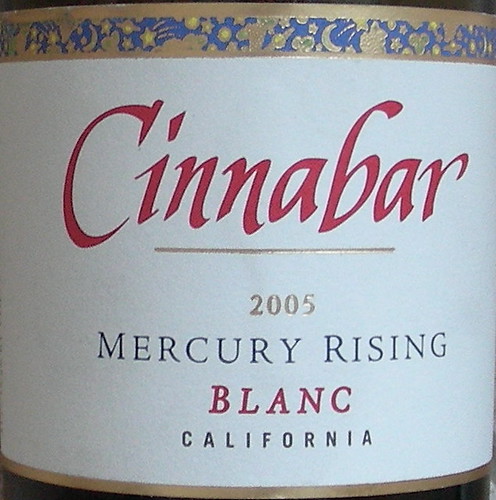 The wine departments of our local grocery stores are getting more and more interesting. You can now find wines from many regions around the world and at the same time, there is often a shelf dedicated to wines made by local wineries. So the other day, I found a 2005 Cinnabar Mercury Rising Blanc at my local Mollie Stone's Market. I already had the Mercury Rising Red — a Bordeaux-style wine — several times, and I was curious to try the white version.
The wine departments of our local grocery stores are getting more and more interesting. You can now find wines from many regions around the world and at the same time, there is often a shelf dedicated to wines made by local wineries. So the other day, I found a 2005 Cinnabar Mercury Rising Blanc at my local Mollie Stone's Market. I already had the Mercury Rising Red — a Bordeaux-style wine — several times, and I was curious to try the white version.Located high on a ridge in the Santa Cruz Mountains, Cinnabar Vineyards & Winery was founded by Tom Mudd, a Stanford grad and research engineer at SRI International (Stanford Research Institute). But after planting a one-acre mountain vineyard in 1974, he decided to change careers, took viticulture and enology courses at the University of California Davis, and finally founded his own winery in 1983.
He chose the name Cinnabar, a brick-red mineral (mercury sulfide) that fascinated the alchemists of the Middle Ages. They would crush and heat up a piece of cinnabar and observe the mercury separate from sulfur and evaporate. Using a similar process, they were hoping to find a way to extract gold and silver from any ordinary metal.
Mercury Rising Blanc is Cinnabar's proprietary white. It is a blend of Sauvignon Blanc, Viognier and Sémillon, sourced in 2005 in Monterey County, Sonoma County and Clarksburg. We opened the wine at a recent holiday potluck lunch where people had brought different ethnic dishes. The wine ended up being very popular. In the glass, it displayed a pale yellow color and a fresh nose of citrus. There was some tangy acidity on the palate followed by lime flavors and minerality on the finish. The wine worked beautifully with the ethnic food, especially the Sashimi salad made with raw flounder and brought by our Japanese friend Misako.
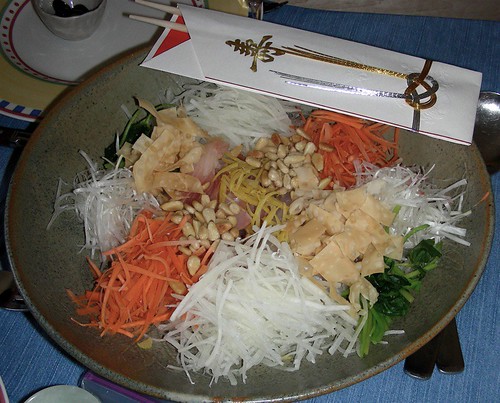
Misako's sashimi salad
Technorati tags: wine food & drink
Wednesday, December 12, 2007
4th Annual Menu for Hope: donate and win food and wine prizes
 Each year, food and wine bloggers from all over the world join forces to promote the Menu for Hope initiative and donate a wide selection of wonderful food and wine related prizes.
Each year, food and wine bloggers from all over the world join forces to promote the Menu for Hope initiative and donate a wide selection of wonderful food and wine related prizes. Menu for Hope is essentially an online raffle with prizes donated by bloggers. For every US$10 they donate, participants receive a virtual raffle ticket toward a prize of their choice. In 2006, Menu for Hope successfully raised US$60,925.12 to help the UN World Food Programme feed the hungry.
This year, Menu for Hope is again supporting the UN World Food Programme and more specifically, the school lunch program in Lesotho, Africa. This program not only keep these children alive but also help them stay in school so that they can learn the necessary skills to feed themselves in the future. This is also a model program in local procurement - buying food locally to support local farmers and the local economy.
Now, how can you help? it is very easy: go to the donation site at Firstgiving and make a donation. Make sure you read the instructions regarding your choice of prize(s). This year, Purple Liquid will donate a Santa Cruz Mountains Wine Sampler, 6 wines from the Santa Cruz Mountains, a world-class wine producing region and home to some of the oldest wineries in California. Use code WB25 for this prize but before that, make sure I can ship the wine to you: the wine can only be shipped to the following states: Alaska, Arizona, California, Colorado, District of Columbia, Hawaii, Idaho, Illinois, Iowa, Louisiana, Missouri, Nebraska, Nevada, New Mexico, New York, North Dakota, Oregon, Texas, Washington, West Virginia, and Wisconsin.
I hope you will be the lucky person I will ship my prize to.
Technorati tags: wine food & drink
Friday, December 07, 2007
Tasting the wines of South America
The wines from South America was the theme of our last wine club tasting event. The selection included three wines from Argentina and four from Chile. The overall impression of the tasting was that many of the wines were big and some rather high in alcohol. These wines were also highly rated by wine critics —six out of seven were rated 90 points and above — showing that these South American wineries had been successfully positioning themselves for the American/European market.
Argentina
Although Argentina is one of the world's top five largest wine producing countries, quality-focused winemaking in Argentina has a young history. Not so long ago, most of Argentina's production was aimed at the local market. However, economic stability over the past decade has encouraged substantial investment — especially from foreign countries — and quality has drastically improved.
In Argentina, the winemaking region spreads along over 2,400 km at the foothills of the Andes. The region is dry and arid, a semi-desert with a wide thermal amplitude between day and night. Irrigation is essential and comes from the melting snow of the Andes. Here, altitude is one of the key factors to growing quality wine grapes. Vineyards are planted at between 2,500 and 5,000 feet to exploit cooler temperatures.
Chile
According to Chilean winemakers, “Chile is a paradise to grow grapes”. Wine has been made in Chile for centuries thanks to a unique combination of climatic and geographical conditions. Chile's wine regions are located in the broad valleys that lie against the Andes Mountains. In these valleys, the climate is generally hot and dry, although always balanced by cooling influences from the cold Pacific Ocean that is rarely more than 80km away.
Thanks to the Andes Mountains, a natural barrier against the invasion of diseases, Chile has never been attacked by the root louse Phylloxera. Therefore, vines can safely grow on their own roots. They can be planted by simply sticking cuttings into the ground without the burden and expense of grafting them on to resistant rootstock.
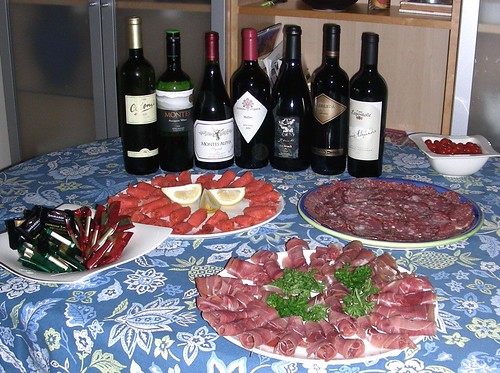
The wines we tasted:
 • 2006 Colomé Torrontés Salsa. Torrontés is Argentina's number one white variety although it is practically unknown in other parts of the world. It produces fragrant and fruity wines with crisp acidity and plenty of body. Bodega Colomé is situated at 7500 feet elevation in the Salta wine region near the base of the Andes and is actually the highest altitude winery in the world. Their Torrontès comes from 80-year-old vines farmed using biodynamic principles. My notes: extremely aromatic, a hint of sweetness, medium-bodied, reminded us of a Viognier.
• 2006 Colomé Torrontés Salsa. Torrontés is Argentina's number one white variety although it is practically unknown in other parts of the world. It produces fragrant and fruity wines with crisp acidity and plenty of body. Bodega Colomé is situated at 7500 feet elevation in the Salta wine region near the base of the Andes and is actually the highest altitude winery in the world. Their Torrontès comes from 80-year-old vines farmed using biodynamic principles. My notes: extremely aromatic, a hint of sweetness, medium-bodied, reminded us of a Viognier.
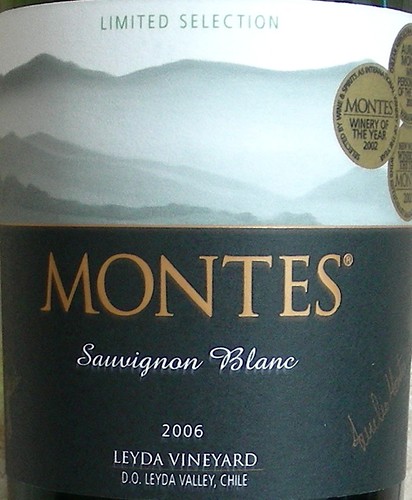 • 2006 Montes Sauvignon Blanc Leyda Vineyard: Viña Montes is a state-of-the-art winery from Chile that was founded in the late 1980s with the mission “to produce the best wines and continue opening markets and bringing the Chilean flag to all the world.”. Every bottle of wine is embossed with a seal that reads “From Chile with pride.” Today, over 90% of the wines from Montes are exported to over 70 different countries throughout the world. This Sauvignon Blanc comes from Leyda Vineyard located north of the Colchagua Valley and slightly cooler thanks due to its proximity to the Pacific Ocean. My notes: very fruity nose, aromas of citrus, crisp, pleasant.
• 2006 Montes Sauvignon Blanc Leyda Vineyard: Viña Montes is a state-of-the-art winery from Chile that was founded in the late 1980s with the mission “to produce the best wines and continue opening markets and bringing the Chilean flag to all the world.”. Every bottle of wine is embossed with a seal that reads “From Chile with pride.” Today, over 90% of the wines from Montes are exported to over 70 different countries throughout the world. This Sauvignon Blanc comes from Leyda Vineyard located north of the Colchagua Valley and slightly cooler thanks due to its proximity to the Pacific Ocean. My notes: very fruity nose, aromas of citrus, crisp, pleasant.
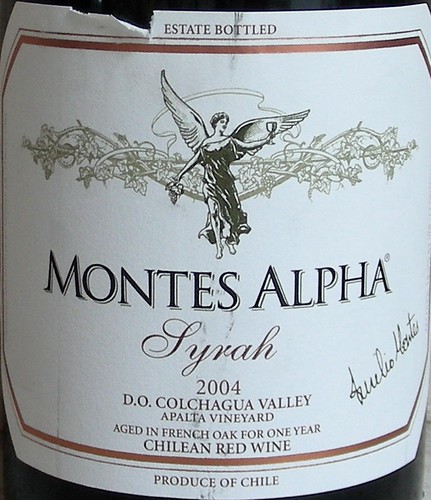 • 2004 Montes Alpha Syrah Apalta Vineyard: The Apalta Vineyard is located in Chile's Colchagua Valley at fairly high elevation, some 40 miles from the coast. The weather is characterized by warm and sunny days and very cool evenings. My notes: purple black color, ripe fruit aromas on the nose, thick, woody, and alcoholic on the palate. Overall, was found bold and for some, unbalanced.
• 2004 Montes Alpha Syrah Apalta Vineyard: The Apalta Vineyard is located in Chile's Colchagua Valley at fairly high elevation, some 40 miles from the coast. The weather is characterized by warm and sunny days and very cool evenings. My notes: purple black color, ripe fruit aromas on the nose, thick, woody, and alcoholic on the palate. Overall, was found bold and for some, unbalanced.
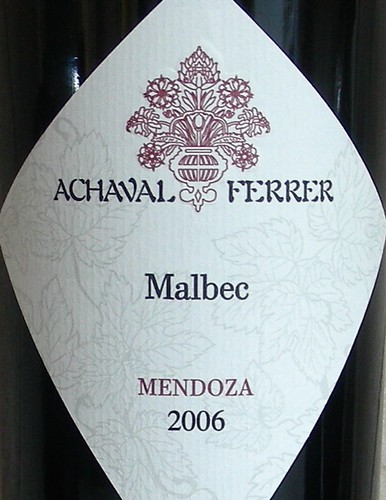 • 2006 Achaval Ferrer Malbec Mendoza: Achaval Ferrer is an Argentinean winery located in the Province of Mendoza, the country's largest wine region. The wine is 100% Malbec, Argentina's great red grape. Malbec is also one of the traditional Bordeaux varietals and the dominant red varietal in the Cahors appellation. Argentinian Malbecs are sometimes considered the best in the world. My notes: dark purple color, black fruit and pepper on the nose, some tannins and acidity on the palate. Nice yet not overly complex.
• 2006 Achaval Ferrer Malbec Mendoza: Achaval Ferrer is an Argentinean winery located in the Province of Mendoza, the country's largest wine region. The wine is 100% Malbec, Argentina's great red grape. Malbec is also one of the traditional Bordeaux varietals and the dominant red varietal in the Cahors appellation. Argentinian Malbecs are sometimes considered the best in the world. My notes: dark purple color, black fruit and pepper on the nose, some tannins and acidity on the palate. Nice yet not overly complex.
 • 2003 Tikal Patriota: from the Mendoza wine region in Argentina, this is a blend of Bonarda and Malbec. Unrelated to the Piedmont grape Bonarda Piemontese, Argentina's Bonarda may be the same grape as Charbono a variety of French origin and imported from California. Bonarda is today the second most widely planted grape variety in Argentina after Malbec. My notes: dark color, rich fruity flavors, well-balanced with some complexity. One of my favorite wines of the evening.
• 2003 Tikal Patriota: from the Mendoza wine region in Argentina, this is a blend of Bonarda and Malbec. Unrelated to the Piedmont grape Bonarda Piemontese, Argentina's Bonarda may be the same grape as Charbono a variety of French origin and imported from California. Bonarda is today the second most widely planted grape variety in Argentina after Malbec. My notes: dark color, rich fruity flavors, well-balanced with some complexity. One of my favorite wines of the evening.
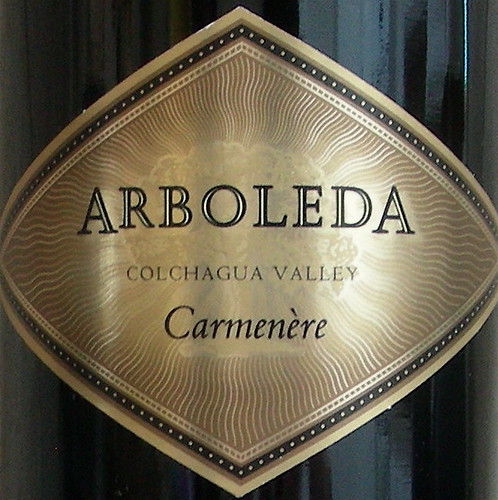 • 2005 Arboleda Carmenère: Also a traditional Bordeaux varietal, Carmenère is currently the rising star of the Chilean wine industry. Because of its susceptibility to mildew and pests, it is rarely used in Bordeaux anymore and as of today, Chile produces the vast majority of Carmenère wines with more than 4,000 hectares cultivated. Arboleda, which in Spanish means grove of trees, is a company founded in 1999 by Robert Mondavi and Eduardo Chadwick of Viña Errázuriz. My notes: deep color, aromas of black fruit and bittersweet dark cocoa, smoky, round mouthfeel, dusty finish. Another favorite of mine.
• 2005 Arboleda Carmenère: Also a traditional Bordeaux varietal, Carmenère is currently the rising star of the Chilean wine industry. Because of its susceptibility to mildew and pests, it is rarely used in Bordeaux anymore and as of today, Chile produces the vast majority of Carmenère wines with more than 4,000 hectares cultivated. Arboleda, which in Spanish means grove of trees, is a company founded in 1999 by Robert Mondavi and Eduardo Chadwick of Viña Errázuriz. My notes: deep color, aromas of black fruit and bittersweet dark cocoa, smoky, round mouthfeel, dusty finish. Another favorite of mine.
 • 2005 Casa Lapostolle Cabernet Sauvignon Cuvée Alexandre: The Marnier-Lapostolle family, creator of the Grand Marnier liqueur, founded Casa Lapostolle in 1994, purchasing an old wine estate in Chile's Colchagua Valley. The cuvée Alexandre is named after the owner's great-grandfather, Alexandre Marnier, who created Grand Marnier in 1880. It is a blend of 85% Cabernet Sauvignon, 15% Merlot coming from non irrigated 60 year old vines. My notes: deep red color, black berries on the nose, firm on the palate with tannins. Seems too young to be drunk now for my taste, should age a little bit longer.
• 2005 Casa Lapostolle Cabernet Sauvignon Cuvée Alexandre: The Marnier-Lapostolle family, creator of the Grand Marnier liqueur, founded Casa Lapostolle in 1994, purchasing an old wine estate in Chile's Colchagua Valley. The cuvée Alexandre is named after the owner's great-grandfather, Alexandre Marnier, who created Grand Marnier in 1880. It is a blend of 85% Cabernet Sauvignon, 15% Merlot coming from non irrigated 60 year old vines. My notes: deep red color, black berries on the nose, firm on the palate with tannins. Seems too young to be drunk now for my taste, should age a little bit longer.
Our next tasting event is our traditional end of the year Champagne tasting. We'll have a great selection of wines, mostly from small Champagne growers so don't miss it!
Previous wine club tastings:
• Tasting Summer Wines from around the Mediterranean Sea
• Guess the wine tasting
• Tasting the wines of Australia and New Zealand
Technorati tags: wine food & drink
Argentina
Although Argentina is one of the world's top five largest wine producing countries, quality-focused winemaking in Argentina has a young history. Not so long ago, most of Argentina's production was aimed at the local market. However, economic stability over the past decade has encouraged substantial investment — especially from foreign countries — and quality has drastically improved.
In Argentina, the winemaking region spreads along over 2,400 km at the foothills of the Andes. The region is dry and arid, a semi-desert with a wide thermal amplitude between day and night. Irrigation is essential and comes from the melting snow of the Andes. Here, altitude is one of the key factors to growing quality wine grapes. Vineyards are planted at between 2,500 and 5,000 feet to exploit cooler temperatures.
Chile
According to Chilean winemakers, “Chile is a paradise to grow grapes”. Wine has been made in Chile for centuries thanks to a unique combination of climatic and geographical conditions. Chile's wine regions are located in the broad valleys that lie against the Andes Mountains. In these valleys, the climate is generally hot and dry, although always balanced by cooling influences from the cold Pacific Ocean that is rarely more than 80km away.
Thanks to the Andes Mountains, a natural barrier against the invasion of diseases, Chile has never been attacked by the root louse Phylloxera. Therefore, vines can safely grow on their own roots. They can be planted by simply sticking cuttings into the ground without the burden and expense of grafting them on to resistant rootstock.

The wines we tasted:
 • 2006 Colomé Torrontés Salsa. Torrontés is Argentina's number one white variety although it is practically unknown in other parts of the world. It produces fragrant and fruity wines with crisp acidity and plenty of body. Bodega Colomé is situated at 7500 feet elevation in the Salta wine region near the base of the Andes and is actually the highest altitude winery in the world. Their Torrontès comes from 80-year-old vines farmed using biodynamic principles. My notes: extremely aromatic, a hint of sweetness, medium-bodied, reminded us of a Viognier.
• 2006 Colomé Torrontés Salsa. Torrontés is Argentina's number one white variety although it is practically unknown in other parts of the world. It produces fragrant and fruity wines with crisp acidity and plenty of body. Bodega Colomé is situated at 7500 feet elevation in the Salta wine region near the base of the Andes and is actually the highest altitude winery in the world. Their Torrontès comes from 80-year-old vines farmed using biodynamic principles. My notes: extremely aromatic, a hint of sweetness, medium-bodied, reminded us of a Viognier.  • 2006 Montes Sauvignon Blanc Leyda Vineyard: Viña Montes is a state-of-the-art winery from Chile that was founded in the late 1980s with the mission “to produce the best wines and continue opening markets and bringing the Chilean flag to all the world.”. Every bottle of wine is embossed with a seal that reads “From Chile with pride.” Today, over 90% of the wines from Montes are exported to over 70 different countries throughout the world. This Sauvignon Blanc comes from Leyda Vineyard located north of the Colchagua Valley and slightly cooler thanks due to its proximity to the Pacific Ocean. My notes: very fruity nose, aromas of citrus, crisp, pleasant.
• 2006 Montes Sauvignon Blanc Leyda Vineyard: Viña Montes is a state-of-the-art winery from Chile that was founded in the late 1980s with the mission “to produce the best wines and continue opening markets and bringing the Chilean flag to all the world.”. Every bottle of wine is embossed with a seal that reads “From Chile with pride.” Today, over 90% of the wines from Montes are exported to over 70 different countries throughout the world. This Sauvignon Blanc comes from Leyda Vineyard located north of the Colchagua Valley and slightly cooler thanks due to its proximity to the Pacific Ocean. My notes: very fruity nose, aromas of citrus, crisp, pleasant. • 2004 Montes Alpha Syrah Apalta Vineyard: The Apalta Vineyard is located in Chile's Colchagua Valley at fairly high elevation, some 40 miles from the coast. The weather is characterized by warm and sunny days and very cool evenings. My notes: purple black color, ripe fruit aromas on the nose, thick, woody, and alcoholic on the palate. Overall, was found bold and for some, unbalanced.
• 2004 Montes Alpha Syrah Apalta Vineyard: The Apalta Vineyard is located in Chile's Colchagua Valley at fairly high elevation, some 40 miles from the coast. The weather is characterized by warm and sunny days and very cool evenings. My notes: purple black color, ripe fruit aromas on the nose, thick, woody, and alcoholic on the palate. Overall, was found bold and for some, unbalanced. • 2006 Achaval Ferrer Malbec Mendoza: Achaval Ferrer is an Argentinean winery located in the Province of Mendoza, the country's largest wine region. The wine is 100% Malbec, Argentina's great red grape. Malbec is also one of the traditional Bordeaux varietals and the dominant red varietal in the Cahors appellation. Argentinian Malbecs are sometimes considered the best in the world. My notes: dark purple color, black fruit and pepper on the nose, some tannins and acidity on the palate. Nice yet not overly complex.
• 2006 Achaval Ferrer Malbec Mendoza: Achaval Ferrer is an Argentinean winery located in the Province of Mendoza, the country's largest wine region. The wine is 100% Malbec, Argentina's great red grape. Malbec is also one of the traditional Bordeaux varietals and the dominant red varietal in the Cahors appellation. Argentinian Malbecs are sometimes considered the best in the world. My notes: dark purple color, black fruit and pepper on the nose, some tannins and acidity on the palate. Nice yet not overly complex. • 2003 Tikal Patriota: from the Mendoza wine region in Argentina, this is a blend of Bonarda and Malbec. Unrelated to the Piedmont grape Bonarda Piemontese, Argentina's Bonarda may be the same grape as Charbono a variety of French origin and imported from California. Bonarda is today the second most widely planted grape variety in Argentina after Malbec. My notes: dark color, rich fruity flavors, well-balanced with some complexity. One of my favorite wines of the evening.
• 2003 Tikal Patriota: from the Mendoza wine region in Argentina, this is a blend of Bonarda and Malbec. Unrelated to the Piedmont grape Bonarda Piemontese, Argentina's Bonarda may be the same grape as Charbono a variety of French origin and imported from California. Bonarda is today the second most widely planted grape variety in Argentina after Malbec. My notes: dark color, rich fruity flavors, well-balanced with some complexity. One of my favorite wines of the evening. • 2005 Arboleda Carmenère: Also a traditional Bordeaux varietal, Carmenère is currently the rising star of the Chilean wine industry. Because of its susceptibility to mildew and pests, it is rarely used in Bordeaux anymore and as of today, Chile produces the vast majority of Carmenère wines with more than 4,000 hectares cultivated. Arboleda, which in Spanish means grove of trees, is a company founded in 1999 by Robert Mondavi and Eduardo Chadwick of Viña Errázuriz. My notes: deep color, aromas of black fruit and bittersweet dark cocoa, smoky, round mouthfeel, dusty finish. Another favorite of mine.
• 2005 Arboleda Carmenère: Also a traditional Bordeaux varietal, Carmenère is currently the rising star of the Chilean wine industry. Because of its susceptibility to mildew and pests, it is rarely used in Bordeaux anymore and as of today, Chile produces the vast majority of Carmenère wines with more than 4,000 hectares cultivated. Arboleda, which in Spanish means grove of trees, is a company founded in 1999 by Robert Mondavi and Eduardo Chadwick of Viña Errázuriz. My notes: deep color, aromas of black fruit and bittersweet dark cocoa, smoky, round mouthfeel, dusty finish. Another favorite of mine. • 2005 Casa Lapostolle Cabernet Sauvignon Cuvée Alexandre: The Marnier-Lapostolle family, creator of the Grand Marnier liqueur, founded Casa Lapostolle in 1994, purchasing an old wine estate in Chile's Colchagua Valley. The cuvée Alexandre is named after the owner's great-grandfather, Alexandre Marnier, who created Grand Marnier in 1880. It is a blend of 85% Cabernet Sauvignon, 15% Merlot coming from non irrigated 60 year old vines. My notes: deep red color, black berries on the nose, firm on the palate with tannins. Seems too young to be drunk now for my taste, should age a little bit longer.
• 2005 Casa Lapostolle Cabernet Sauvignon Cuvée Alexandre: The Marnier-Lapostolle family, creator of the Grand Marnier liqueur, founded Casa Lapostolle in 1994, purchasing an old wine estate in Chile's Colchagua Valley. The cuvée Alexandre is named after the owner's great-grandfather, Alexandre Marnier, who created Grand Marnier in 1880. It is a blend of 85% Cabernet Sauvignon, 15% Merlot coming from non irrigated 60 year old vines. My notes: deep red color, black berries on the nose, firm on the palate with tannins. Seems too young to be drunk now for my taste, should age a little bit longer.Our next tasting event is our traditional end of the year Champagne tasting. We'll have a great selection of wines, mostly from small Champagne growers so don't miss it!
Previous wine club tastings:
• Tasting Summer Wines from around the Mediterranean Sea
• Guess the wine tasting
• Tasting the wines of Australia and New Zealand
Technorati tags: wine food & drink
Wednesday, December 05, 2007
With the turkey leftovers, a magnum of 2003 Ridge Lytton Springs
My friend Catherine has delicious ways to accomodate turkey leftovers. So the day after Thanksgiving, she made a soup with what was left of the turkey carcass. She had to cook the carcass for at least four hours to produce the broth, and then she made the soup with the broth, chopped vegetables, and diced turkey.
She also showed us how to make turkey croquettes with leftover mashed potatoes. Simply served with a green salad, they were the ultimate comfort dish: crispy on the outside, moist and tasty on the inside.
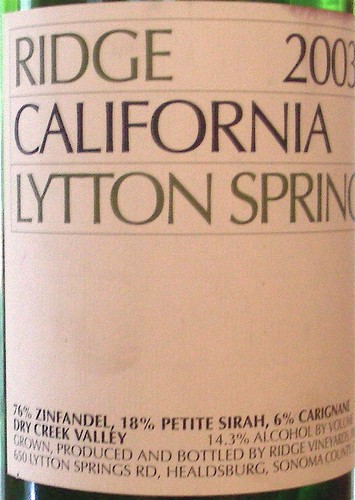 And we were far from running out of wine as it was time to open the magnum of 2003 Ridge Lytton Springs that our friend Pierre had brought.
And we were far from running out of wine as it was time to open the magnum of 2003 Ridge Lytton Springs that our friend Pierre had brought.
It's in 1972 that Ridge Vineyards started making its first Lytton Springs Zinfandel from 80 year old vines, and in the early 1990s, the winery was able to purchase the land. The place is named after "Captain" William Litton, the actual owner in the 1870s. It was later in the early 1900s that the spelling changed to Lytton.
The vineyard is located north of Sonoma County, in the hills that separate the Dry Creek and Alexander Valleys. It is mostly planted to Zinfandel — including some 111-year-old vines — as well as Petite Sirah, Carignane, a small amount of Mataro (Mourvèdre), and Grenache.
The wine had deep red color and a rich combination of red and black fruits on the nose. The palate had some good acidity and sweet berry aromas without being jammy at all. Overall, the wine was very well balanced, offering much more finesse than most. I was happy: I too rarely find a Zinfandel that I like.
Technorati tags: wine food & drink
She also showed us how to make turkey croquettes with leftover mashed potatoes. Simply served with a green salad, they were the ultimate comfort dish: crispy on the outside, moist and tasty on the inside.
 And we were far from running out of wine as it was time to open the magnum of 2003 Ridge Lytton Springs that our friend Pierre had brought.
And we were far from running out of wine as it was time to open the magnum of 2003 Ridge Lytton Springs that our friend Pierre had brought.It's in 1972 that Ridge Vineyards started making its first Lytton Springs Zinfandel from 80 year old vines, and in the early 1990s, the winery was able to purchase the land. The place is named after "Captain" William Litton, the actual owner in the 1870s. It was later in the early 1900s that the spelling changed to Lytton.
The vineyard is located north of Sonoma County, in the hills that separate the Dry Creek and Alexander Valleys. It is mostly planted to Zinfandel — including some 111-year-old vines — as well as Petite Sirah, Carignane, a small amount of Mataro (Mourvèdre), and Grenache.
The wine had deep red color and a rich combination of red and black fruits on the nose. The palate had some good acidity and sweet berry aromas without being jammy at all. Overall, the wine was very well balanced, offering much more finesse than most. I was happy: I too rarely find a Zinfandel that I like.
Technorati tags: wine food & drink
Thursday, November 29, 2007
A memorable Thanksgiving dinner
We spent Thanksgiving in Tahoe with our dear friends Catherine and Pierre and their children. The weather was sunny and cold — no snow — which was perfect for early afternoon hikes and the rest of the day dedicated to various activities including cooking, knitting, reading, playing games, and eating of course. Actually, cooking was the main activity of this extended weekend and our friend Catherine being an awesome cook, I can tell you that everything that came out of the kitchen was incredibly delicious. She was the one in charge of course, the rest of us helping with basic tasks such as slicing, dicing, and mincing.

The turkey in its citrus flavored brine
 >
>
The roasted turkey
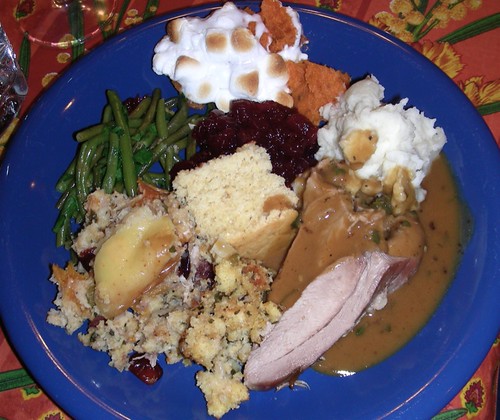
A sampling of turkey, cornbread stuffing, and side dishes
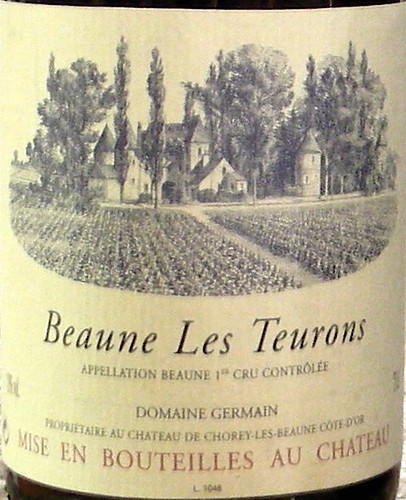 Our friend Pierre had brought the wine: a 1997 Beaune Premier Cru Les Teurons Domaine Germain that they had bought at the Château de Chorey while vacationing in Burgundy. The domaine includes a renovated castle with five chambres d'hôtes and one suite, as well as several Beaune Premier Cru vineyards mostly planted with old vines. Les Teurons is a 21.04 ha premier cru vineyard known to produce elegant wines which are round, rich and balanced. The wine had a clear light red color with a fragrant nose of floral and fruity aromas. On the palate, it was well-aged, balanced and harmonious, leaving a light smoky note on the finish.
Our friend Pierre had brought the wine: a 1997 Beaune Premier Cru Les Teurons Domaine Germain that they had bought at the Château de Chorey while vacationing in Burgundy. The domaine includes a renovated castle with five chambres d'hôtes and one suite, as well as several Beaune Premier Cru vineyards mostly planted with old vines. Les Teurons is a 21.04 ha premier cru vineyard known to produce elegant wines which are round, rich and balanced. The wine had a clear light red color with a fragrant nose of floral and fruity aromas. On the palate, it was well-aged, balanced and harmonious, leaving a light smoky note on the finish.
After the turkey feast, we went for a walk, in order to make room for the dessert: a very yummy pear tart tatin that my daughter had made.

The pear tart tatin: seems crumbly but was actually very yummy
Technorati tags: wine food & drink

The turkey in its citrus flavored brine
 >
>The roasted turkey

A sampling of turkey, cornbread stuffing, and side dishes
 Our friend Pierre had brought the wine: a 1997 Beaune Premier Cru Les Teurons Domaine Germain that they had bought at the Château de Chorey while vacationing in Burgundy. The domaine includes a renovated castle with five chambres d'hôtes and one suite, as well as several Beaune Premier Cru vineyards mostly planted with old vines. Les Teurons is a 21.04 ha premier cru vineyard known to produce elegant wines which are round, rich and balanced. The wine had a clear light red color with a fragrant nose of floral and fruity aromas. On the palate, it was well-aged, balanced and harmonious, leaving a light smoky note on the finish.
Our friend Pierre had brought the wine: a 1997 Beaune Premier Cru Les Teurons Domaine Germain that they had bought at the Château de Chorey while vacationing in Burgundy. The domaine includes a renovated castle with five chambres d'hôtes and one suite, as well as several Beaune Premier Cru vineyards mostly planted with old vines. Les Teurons is a 21.04 ha premier cru vineyard known to produce elegant wines which are round, rich and balanced. The wine had a clear light red color with a fragrant nose of floral and fruity aromas. On the palate, it was well-aged, balanced and harmonious, leaving a light smoky note on the finish. After the turkey feast, we went for a walk, in order to make room for the dessert: a very yummy pear tart tatin that my daughter had made.

The pear tart tatin: seems crumbly but was actually very yummy
Technorati tags: wine food & drink
Wednesday, November 14, 2007
WBW #39: a wine from Silver Burgundy, the 2005 Viré-Clessé Maison Chanson
Can you find a good Burgundy at a reasonable price? Yes, says the Brooklynguy, who is hosting this month's 39th edition of Wine Blogging Wednesday. Just consider the wines from Silver Burgundy, the southern part of Burgundy that includes the Côte Chalonnaise and the Mâconnais.
 If you're a Burgundy lover, you may know that the Mâconnais is one of the best sources of good value Chardonnays. The 2005 Viré-Clessé Maison Chanson comes from that region. Created in 1999, Viré-Clessé is one of France's newest appellations. It is made of two villages, Viré and Clessé, located about 15 kilometers north of Mâcon, and previously part of the Mâcon-Villages appellation. The terroir is good with south-east facing slopes and soils of clay and limestone. Only white wines are produced in the area as Chardonnay is the only varietal allowed in the appellation.
If you're a Burgundy lover, you may know that the Mâconnais is one of the best sources of good value Chardonnays. The 2005 Viré-Clessé Maison Chanson comes from that region. Created in 1999, Viré-Clessé is one of France's newest appellations. It is made of two villages, Viré and Clessé, located about 15 kilometers north of Mâcon, and previously part of the Mâcon-Villages appellation. The terroir is good with south-east facing slopes and soils of clay and limestone. Only white wines are produced in the area as Chardonnay is the only varietal allowed in the appellation.
The producer is the Beaune based Maison Chanson, a négociant house founded in 1750 and now part of the Champagne Bollinger group. The domaine owns premium vineyards around Beaune, Savigny-lès-Beaune, and Pernand-Vergelesses. While a quarter of the production comes from estate fruits, the rest is being sourced from selected growers.
The wine is from the 2005 vintage, which was exceptional in Burgundy. The growing season was characterized by a cold winter, a rainy spring followed by a hot and dry summer. During harvest, the grapes were picked at optimum ripeness and in perfect health. The wine shows a light golden color and toasted nuts and pears on the nose. On the palate, it is fresh and creamy with a mineral finish.
Overall, it is a very nice wine and a good accompaniment to fish. Try it with Poached Fish with Lemon and Capers.
And thanks for hosting Brooklynguy!
Previous WBW posts:
• WBW #38: 2001 Periquita Classico
• WBW #37: Hello Teroldego!
• WBW #34: 2002 Stella Maris Red Columbia Valley
Technorati tags:: wine food & drinkwine blogging wednesday wbw wbw39
 If you're a Burgundy lover, you may know that the Mâconnais is one of the best sources of good value Chardonnays. The 2005 Viré-Clessé Maison Chanson comes from that region. Created in 1999, Viré-Clessé is one of France's newest appellations. It is made of two villages, Viré and Clessé, located about 15 kilometers north of Mâcon, and previously part of the Mâcon-Villages appellation. The terroir is good with south-east facing slopes and soils of clay and limestone. Only white wines are produced in the area as Chardonnay is the only varietal allowed in the appellation.
If you're a Burgundy lover, you may know that the Mâconnais is one of the best sources of good value Chardonnays. The 2005 Viré-Clessé Maison Chanson comes from that region. Created in 1999, Viré-Clessé is one of France's newest appellations. It is made of two villages, Viré and Clessé, located about 15 kilometers north of Mâcon, and previously part of the Mâcon-Villages appellation. The terroir is good with south-east facing slopes and soils of clay and limestone. Only white wines are produced in the area as Chardonnay is the only varietal allowed in the appellation.The producer is the Beaune based Maison Chanson, a négociant house founded in 1750 and now part of the Champagne Bollinger group. The domaine owns premium vineyards around Beaune, Savigny-lès-Beaune, and Pernand-Vergelesses. While a quarter of the production comes from estate fruits, the rest is being sourced from selected growers.
The wine is from the 2005 vintage, which was exceptional in Burgundy. The growing season was characterized by a cold winter, a rainy spring followed by a hot and dry summer. During harvest, the grapes were picked at optimum ripeness and in perfect health. The wine shows a light golden color and toasted nuts and pears on the nose. On the palate, it is fresh and creamy with a mineral finish.
Overall, it is a very nice wine and a good accompaniment to fish. Try it with Poached Fish with Lemon and Capers.
And thanks for hosting Brooklynguy!
Previous WBW posts:
• WBW #38: 2001 Periquita Classico
• WBW #37: Hello Teroldego!
• WBW #34: 2002 Stella Maris Red Columbia Valley
Technorati tags:: wine food & drinkwine blogging wednesday wbw wbw39
Thursday, November 08, 2007
2005 La Dame Blanche du Château Kefraya
 This wine was a silent auction item that I bought at my children's school, graciously donated by the Lebanese restaurant Illusions Fayrouz in Palo Alto. I had been curious to taste it since the day I won it at the auction, so the other night, I felt that it was time to give it a try.
This wine was a silent auction item that I bought at my children's school, graciously donated by the Lebanese restaurant Illusions Fayrouz in Palo Alto. I had been curious to taste it since the day I won it at the auction, so the other night, I felt that it was time to give it a try.Lebanon is one of the oldest wine regions in the world. Viticulture was established in the Bekaa Valley — the country's main wine producing area — about 6000 years ago. Located 30 kilometers east of Beirut, the Bekaa valley is has a Mediterranean climate with wet winters and dry, warm summers, and an average altitude of 1000 meters above sea level. The Château Kefraya is the second biggest winery in the Bekaa valley. It is a 300 hectares estate with terraced vineyards planted at an altitude of 950 to 1100 meters on clayey, limy and stony soils. The wine production is mostly red but includes two whites: Casta Diva and La Dame Blanche
The 2005 La Dame Blanche du Château Kefraya is a blend of Mediterranean varieties including Ugni Blanc, Bourboulenc, and Clairette. It has a straw-yellow color and a nose of floral and honey aromas. The palate is round and full with some good acidity and a nice finish of garrigue herbs. The wine strongly reminds me of a Coteaux du Languedoc and will work well with many Mediterranean dishes. I recommend it with a Provencal style Baked Fish.
Technorati tags: wine food & drink
Wednesday, October 31, 2007
For Halloween, try a really good Pinot
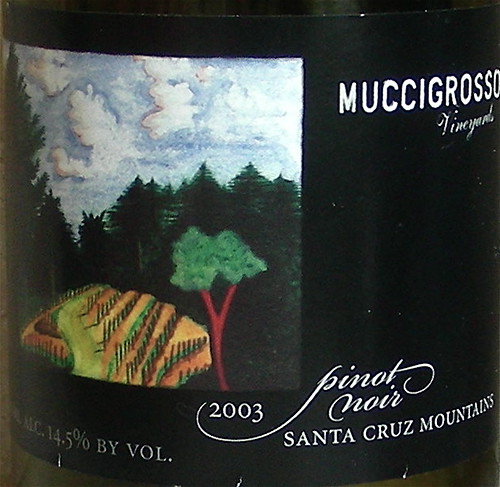 Forget the candies tonight, they're too sweet and not wine friendly at all. Have a glass of wine instead, for example, the 2003 Muccigrosso Pinot Noir from the Santa Cruz Mountains. This is one of my favorite Pinots. It is medium red in color with an attractive nose of sweet berry fruit. The palate is juicy, fruity and very well-balanced in terms of acidity and tannins. The finish is long and spicy. This is the kind of Pinot Noir that has more fruit and body than a Burgundy but is not as big, jammy, Syrah-like as so many California Pinots.
Forget the candies tonight, they're too sweet and not wine friendly at all. Have a glass of wine instead, for example, the 2003 Muccigrosso Pinot Noir from the Santa Cruz Mountains. This is one of my favorite Pinots. It is medium red in color with an attractive nose of sweet berry fruit. The palate is juicy, fruity and very well-balanced in terms of acidity and tannins. The finish is long and spicy. This is the kind of Pinot Noir that has more fruit and body than a Burgundy but is not as big, jammy, Syrah-like as so many California Pinots.As a bonus point, it works very well with pumpkin. Enjoy it with a Pumpkin Risotto that you can make with the remaining flesh left over from your pumpkin carving.

Technorati tags: wine food & drink
Thursday, October 25, 2007
Summer Wines from around the Mediterranean Sea
Our last wine club tasting event was in September, kindly hosted by my sister in law. This was our first gathering after the long summer break and it was great to see everybody again. And this time, in order to prolong our summer vacation memories, I had decided to select a set of summer wines from different Mediterranean regions.
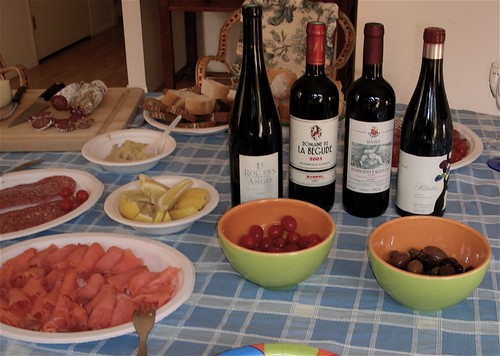
So that day, we tasted 7 different wines, two whites, one rosé, and four reds, from Greece, Spain, Sicily, Provence, and Roussillon. Here are my notes:
 • 2006 Sigalas Santorini Assyrtiko. Santorini is the southernmost and maybe the most beautiful member of the Cyclades islands in the Aegean Sea. It is a a volcanic island that suffered a devastating explosion around 1500 BC, leaving a huge, submerged caldera where the center of the Island had been. The island is covered with volcanic ash, lava and pumice stone, perfect soil conditions to grow vines. There is little rain during the year, except in winter. However, nocturnal moisture coming from the sea brings needed water to the vines. The dominant white grape is Assyrtiko, often described as Greece's best white varietal. Growing on the arid, volcanic soils of Santorini, the varietal is known to produce very distinctive wines. My notes: Light yellow color, aromas of white flowers on the nose, fresh acidity on the palate. The perfect summer sipper.
• 2006 Sigalas Santorini Assyrtiko. Santorini is the southernmost and maybe the most beautiful member of the Cyclades islands in the Aegean Sea. It is a a volcanic island that suffered a devastating explosion around 1500 BC, leaving a huge, submerged caldera where the center of the Island had been. The island is covered with volcanic ash, lava and pumice stone, perfect soil conditions to grow vines. There is little rain during the year, except in winter. However, nocturnal moisture coming from the sea brings needed water to the vines. The dominant white grape is Assyrtiko, often described as Greece's best white varietal. Growing on the arid, volcanic soils of Santorini, the varietal is known to produce very distinctive wines. My notes: Light yellow color, aromas of white flowers on the nose, fresh acidity on the palate. The perfect summer sipper.
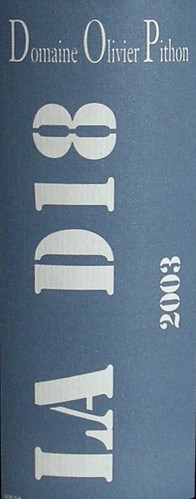 • 2003 Vin de Pays des Côtes Catalanes Blanc Domaine Olivier Pithon La D18: Olivier Pithon has been involved in winemaking from an early age. His Grandfather was making wines in Anjou and his brother is one of the best Loire Valley producers. The D18 cuvée was named after a local breathtaking road that goes through the Corbières mountains, west of Perpignan, and is based on a selection of the best slopes of White and Grey Grenache. My notes: yellow color, herbal nose, oxidized sherry flavors on the palate. Was the wine flawed?
• 2003 Vin de Pays des Côtes Catalanes Blanc Domaine Olivier Pithon La D18: Olivier Pithon has been involved in winemaking from an early age. His Grandfather was making wines in Anjou and his brother is one of the best Loire Valley producers. The D18 cuvée was named after a local breathtaking road that goes through the Corbières mountains, west of Perpignan, and is based on a selection of the best slopes of White and Grey Grenache. My notes: yellow color, herbal nose, oxidized sherry flavors on the palate. Was the wine flawed?
 • 2006 Côtes de Provence Rosé Château de Pampelonne: The wine comes from the ultra-trendy Saint Tropez peninsula. It's a typical rosé of Provence, blending Mediteranean varieties such as Tibouren, Cinsault, Grenache, and Syrah. My notes: light salmon color and aromas of citrus and red berries. On the palate, dry and crisp, with a mineral finish. Very well crafted, perfect with a Pissaladière or some Petits Farcis
• 2006 Côtes de Provence Rosé Château de Pampelonne: The wine comes from the ultra-trendy Saint Tropez peninsula. It's a typical rosé of Provence, blending Mediteranean varieties such as Tibouren, Cinsault, Grenache, and Syrah. My notes: light salmon color and aromas of citrus and red berries. On the palate, dry and crisp, with a mineral finish. Very well crafted, perfect with a Pissaladière or some Petits Farcis
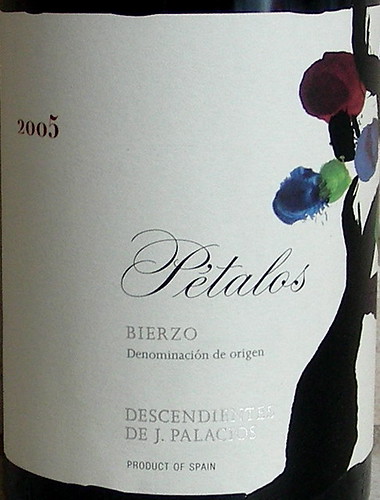 • 2005 Descendientes de Jose Palacios Petalos del Bierzo : Bierzo is a small wine region in Northwestern Spain. The main variety is Mencia, an indigenous grape that was thought to be related to Cabernet Franc. The wine is made by Alvaro Palacios, one of Priorat's leading producers, and his family. My notes: 100% Mencia, dark purple color, peppery nose with notes of violet, thick with tannins on the palate, ripe fruits flavors, long finish. A serious wine.
• 2005 Descendientes de Jose Palacios Petalos del Bierzo : Bierzo is a small wine region in Northwestern Spain. The main variety is Mencia, an indigenous grape that was thought to be related to Cabernet Franc. The wine is made by Alvaro Palacios, one of Priorat's leading producers, and his family. My notes: 100% Mencia, dark purple color, peppery nose with notes of violet, thick with tannins on the palate, ripe fruits flavors, long finish. A serious wine.
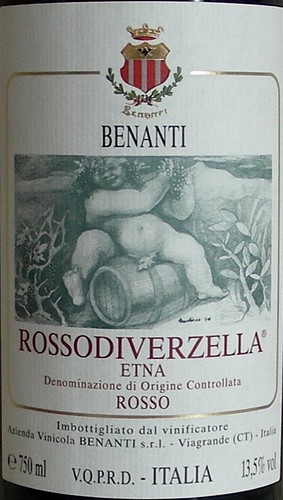 • 2002 Benanti Etna Rosso di Verzella: The wine comes from the volcanic, sun-drenched, arid slopes of Mount Etna. It is a blend of Nerello Mascalese and Nerello Cappuccio, the two main indigenous grape varieties of the Etnean region. The Azienda Vinicola Benanti is one of the best producers of the region and was recently awarded the Winery of the Year title at a Gambero Rosso event in San Francisco. My notes: medium red color, fragrant herbaceous aromas on the nose, fruity, slightly pruny, nice mineral finish. Extremely food friendly.
• 2002 Benanti Etna Rosso di Verzella: The wine comes from the volcanic, sun-drenched, arid slopes of Mount Etna. It is a blend of Nerello Mascalese and Nerello Cappuccio, the two main indigenous grape varieties of the Etnean region. The Azienda Vinicola Benanti is one of the best producers of the region and was recently awarded the Winery of the Year title at a Gambero Rosso event in San Francisco. My notes: medium red color, fragrant herbaceous aromas on the nose, fruity, slightly pruny, nice mineral finish. Extremely food friendly.
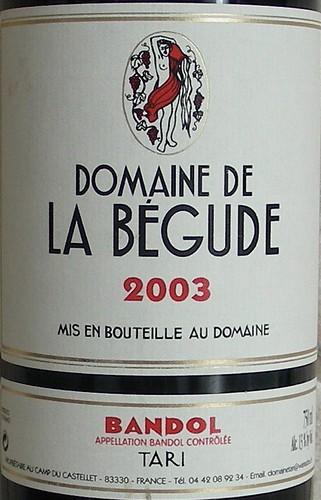 • 2003 Bandol Domaine de la Bégude: The wines of the Bandol appellation are considered the best of Provence. One of the reason for their special typicity is the high amount of Mourvèdre that has to be included in the blend (at least 50% for the appellation). The vineyard of the Domaine de la Bégude is situated at the top of the appellation, 400 meters above the Mediterranean sea. The vines are cultivated on terraces facing south. Their red Bandol is a blend of 85% Mourvèdre and 15% Grenache. My notes: red ruby color, nose of black currant and caramel, elegant and balanced on the palate, aromatic finish. Classy!
• 2003 Bandol Domaine de la Bégude: The wines of the Bandol appellation are considered the best of Provence. One of the reason for their special typicity is the high amount of Mourvèdre that has to be included in the blend (at least 50% for the appellation). The vineyard of the Domaine de la Bégude is situated at the top of the appellation, 400 meters above the Mediterranean sea. The vines are cultivated on terraces facing south. Their red Bandol is a blend of 85% Mourvèdre and 15% Grenache. My notes: red ruby color, nose of black currant and caramel, elegant and balanced on the palate, aromatic finish. Classy!
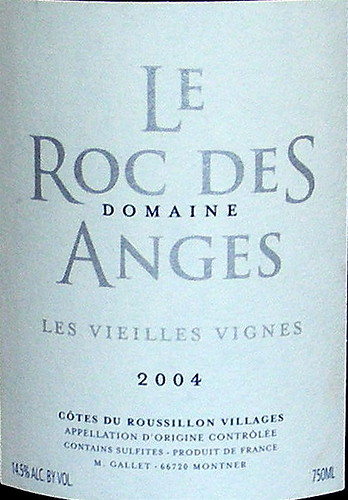 • 2004 Côtes du Roussillon Domaine Le Roc des Anges Vieilles Vignes: The Domaine des Anges is a 13 hectare estate located 30 kilometers northwest of Perpigan in the Côtes du Roussillon appellation. The vineyard comprises old vines of Carignan, Grenache Gris, Grenache Noir, Syrah, and Maccabeu growing on decomposed flaky schists, which allow excellent drainage and encourage the vines to form deep root systems. The Vieilles Vignes cuvée is a blend of 40% Carignan, 40% Grenache Noir, and 20% Syrah with an average vine age of around 70 years old. My notes: dark color, nose of ripe black fruits, rich and full on the palate, almost chewy. Should be perfect with a beef stew.
• 2004 Côtes du Roussillon Domaine Le Roc des Anges Vieilles Vignes: The Domaine des Anges is a 13 hectare estate located 30 kilometers northwest of Perpigan in the Côtes du Roussillon appellation. The vineyard comprises old vines of Carignan, Grenache Gris, Grenache Noir, Syrah, and Maccabeu growing on decomposed flaky schists, which allow excellent drainage and encourage the vines to form deep root systems. The Vieilles Vignes cuvée is a blend of 40% Carignan, 40% Grenache Noir, and 20% Syrah with an average vine age of around 70 years old. My notes: dark color, nose of ripe black fruits, rich and full on the palate, almost chewy. Should be perfect with a beef stew.
Our next tasting event will feature a selection of wines from Argentina and Chile. These two countries are making better wines than ever and they are still very affordable, so stay tuned!
Previous wine club tastings:
• Guess the wine tasting
• Tasting the wines of Australia and New Zealand
• Tasting the wines of Piedmont
Technorati tags: wine food & drink

So that day, we tasted 7 different wines, two whites, one rosé, and four reds, from Greece, Spain, Sicily, Provence, and Roussillon. Here are my notes:
 • 2006 Sigalas Santorini Assyrtiko. Santorini is the southernmost and maybe the most beautiful member of the Cyclades islands in the Aegean Sea. It is a a volcanic island that suffered a devastating explosion around 1500 BC, leaving a huge, submerged caldera where the center of the Island had been. The island is covered with volcanic ash, lava and pumice stone, perfect soil conditions to grow vines. There is little rain during the year, except in winter. However, nocturnal moisture coming from the sea brings needed water to the vines. The dominant white grape is Assyrtiko, often described as Greece's best white varietal. Growing on the arid, volcanic soils of Santorini, the varietal is known to produce very distinctive wines. My notes: Light yellow color, aromas of white flowers on the nose, fresh acidity on the palate. The perfect summer sipper.
• 2006 Sigalas Santorini Assyrtiko. Santorini is the southernmost and maybe the most beautiful member of the Cyclades islands in the Aegean Sea. It is a a volcanic island that suffered a devastating explosion around 1500 BC, leaving a huge, submerged caldera where the center of the Island had been. The island is covered with volcanic ash, lava and pumice stone, perfect soil conditions to grow vines. There is little rain during the year, except in winter. However, nocturnal moisture coming from the sea brings needed water to the vines. The dominant white grape is Assyrtiko, often described as Greece's best white varietal. Growing on the arid, volcanic soils of Santorini, the varietal is known to produce very distinctive wines. My notes: Light yellow color, aromas of white flowers on the nose, fresh acidity on the palate. The perfect summer sipper. • 2003 Vin de Pays des Côtes Catalanes Blanc Domaine Olivier Pithon La D18: Olivier Pithon has been involved in winemaking from an early age. His Grandfather was making wines in Anjou and his brother is one of the best Loire Valley producers. The D18 cuvée was named after a local breathtaking road that goes through the Corbières mountains, west of Perpignan, and is based on a selection of the best slopes of White and Grey Grenache. My notes: yellow color, herbal nose, oxidized sherry flavors on the palate. Was the wine flawed?
• 2003 Vin de Pays des Côtes Catalanes Blanc Domaine Olivier Pithon La D18: Olivier Pithon has been involved in winemaking from an early age. His Grandfather was making wines in Anjou and his brother is one of the best Loire Valley producers. The D18 cuvée was named after a local breathtaking road that goes through the Corbières mountains, west of Perpignan, and is based on a selection of the best slopes of White and Grey Grenache. My notes: yellow color, herbal nose, oxidized sherry flavors on the palate. Was the wine flawed? • 2006 Côtes de Provence Rosé Château de Pampelonne: The wine comes from the ultra-trendy Saint Tropez peninsula. It's a typical rosé of Provence, blending Mediteranean varieties such as Tibouren, Cinsault, Grenache, and Syrah. My notes: light salmon color and aromas of citrus and red berries. On the palate, dry and crisp, with a mineral finish. Very well crafted, perfect with a Pissaladière or some Petits Farcis
• 2006 Côtes de Provence Rosé Château de Pampelonne: The wine comes from the ultra-trendy Saint Tropez peninsula. It's a typical rosé of Provence, blending Mediteranean varieties such as Tibouren, Cinsault, Grenache, and Syrah. My notes: light salmon color and aromas of citrus and red berries. On the palate, dry and crisp, with a mineral finish. Very well crafted, perfect with a Pissaladière or some Petits Farcis • 2005 Descendientes de Jose Palacios Petalos del Bierzo : Bierzo is a small wine region in Northwestern Spain. The main variety is Mencia, an indigenous grape that was thought to be related to Cabernet Franc. The wine is made by Alvaro Palacios, one of Priorat's leading producers, and his family. My notes: 100% Mencia, dark purple color, peppery nose with notes of violet, thick with tannins on the palate, ripe fruits flavors, long finish. A serious wine.
• 2005 Descendientes de Jose Palacios Petalos del Bierzo : Bierzo is a small wine region in Northwestern Spain. The main variety is Mencia, an indigenous grape that was thought to be related to Cabernet Franc. The wine is made by Alvaro Palacios, one of Priorat's leading producers, and his family. My notes: 100% Mencia, dark purple color, peppery nose with notes of violet, thick with tannins on the palate, ripe fruits flavors, long finish. A serious wine. • 2002 Benanti Etna Rosso di Verzella: The wine comes from the volcanic, sun-drenched, arid slopes of Mount Etna. It is a blend of Nerello Mascalese and Nerello Cappuccio, the two main indigenous grape varieties of the Etnean region. The Azienda Vinicola Benanti is one of the best producers of the region and was recently awarded the Winery of the Year title at a Gambero Rosso event in San Francisco. My notes: medium red color, fragrant herbaceous aromas on the nose, fruity, slightly pruny, nice mineral finish. Extremely food friendly.
• 2002 Benanti Etna Rosso di Verzella: The wine comes from the volcanic, sun-drenched, arid slopes of Mount Etna. It is a blend of Nerello Mascalese and Nerello Cappuccio, the two main indigenous grape varieties of the Etnean region. The Azienda Vinicola Benanti is one of the best producers of the region and was recently awarded the Winery of the Year title at a Gambero Rosso event in San Francisco. My notes: medium red color, fragrant herbaceous aromas on the nose, fruity, slightly pruny, nice mineral finish. Extremely food friendly. • 2003 Bandol Domaine de la Bégude: The wines of the Bandol appellation are considered the best of Provence. One of the reason for their special typicity is the high amount of Mourvèdre that has to be included in the blend (at least 50% for the appellation). The vineyard of the Domaine de la Bégude is situated at the top of the appellation, 400 meters above the Mediterranean sea. The vines are cultivated on terraces facing south. Their red Bandol is a blend of 85% Mourvèdre and 15% Grenache. My notes: red ruby color, nose of black currant and caramel, elegant and balanced on the palate, aromatic finish. Classy!
• 2003 Bandol Domaine de la Bégude: The wines of the Bandol appellation are considered the best of Provence. One of the reason for their special typicity is the high amount of Mourvèdre that has to be included in the blend (at least 50% for the appellation). The vineyard of the Domaine de la Bégude is situated at the top of the appellation, 400 meters above the Mediterranean sea. The vines are cultivated on terraces facing south. Their red Bandol is a blend of 85% Mourvèdre and 15% Grenache. My notes: red ruby color, nose of black currant and caramel, elegant and balanced on the palate, aromatic finish. Classy! • 2004 Côtes du Roussillon Domaine Le Roc des Anges Vieilles Vignes: The Domaine des Anges is a 13 hectare estate located 30 kilometers northwest of Perpigan in the Côtes du Roussillon appellation. The vineyard comprises old vines of Carignan, Grenache Gris, Grenache Noir, Syrah, and Maccabeu growing on decomposed flaky schists, which allow excellent drainage and encourage the vines to form deep root systems. The Vieilles Vignes cuvée is a blend of 40% Carignan, 40% Grenache Noir, and 20% Syrah with an average vine age of around 70 years old. My notes: dark color, nose of ripe black fruits, rich and full on the palate, almost chewy. Should be perfect with a beef stew.
• 2004 Côtes du Roussillon Domaine Le Roc des Anges Vieilles Vignes: The Domaine des Anges is a 13 hectare estate located 30 kilometers northwest of Perpigan in the Côtes du Roussillon appellation. The vineyard comprises old vines of Carignan, Grenache Gris, Grenache Noir, Syrah, and Maccabeu growing on decomposed flaky schists, which allow excellent drainage and encourage the vines to form deep root systems. The Vieilles Vignes cuvée is a blend of 40% Carignan, 40% Grenache Noir, and 20% Syrah with an average vine age of around 70 years old. My notes: dark color, nose of ripe black fruits, rich and full on the palate, almost chewy. Should be perfect with a beef stew.Our next tasting event will feature a selection of wines from Argentina and Chile. These two countries are making better wines than ever and they are still very affordable, so stay tuned!
Previous wine club tastings:
• Guess the wine tasting
• Tasting the wines of Australia and New Zealand
• Tasting the wines of Piedmont
Technorati tags: wine food & drink
Wednesday, October 17, 2007
2005 Domaine de Sahari Guerrouane Vin Gris Cuvée du Soleil
 Knowing that wines from North Africa are almost impossible to find here, my husband recently came back from Paris with a bottle of Guerrouane gris. It is true that we haven't drunk a wine from North Africa for a long time. When we were still living in France, we used to regularly go to North African restaurants and we would always order a bottle of Moroccan vin gris to accompany our couscous.
Knowing that wines from North Africa are almost impossible to find here, my husband recently came back from Paris with a bottle of Guerrouane gris. It is true that we haven't drunk a wine from North Africa for a long time. When we were still living in France, we used to regularly go to North African restaurants and we would always order a bottle of Moroccan vin gris to accompany our couscous.A vin gris is a pale rosé wine that is produced by leaving the grape juice in contact with the skin for a very short time. Afterward, the winemaking process is similar to the one used for white wines.
Guerrouane is one of the best wine regions of Morocco and has been known for producing wines for more than 2000 years. It is located in the northern part of the country at the foothills of the Atlas Mountains. The Domaine de Sahari, owned by the Maison Malesan of Bordeaux, has 600 hectares of vines growing at an elevation of 550 meters in clay-limestone soils. The estate produces 2 wines, a Guerrouane rouge and a Guerrouane gris.
The 2005 Domaine de Sahari Vin Gris Cuvée du Soleil is a blend of Grenache (40%), Cinsault (50%), and Carignan (10%). When we poured the wine into our glasses, it had a lovely light orange-brick color. The nose was subtle with aromas of honey and red fruit. The palate had an oily mouthfeel, leaving notes of caramel on the finish.
Needless to say, we ate a couscous with the wine. It was actually a Fish Couscous that went particularly well with the vin gris.
Technorati tags: wine food & drink
Wednesday, October 10, 2007
WBW #38: 2001 Periquita Classico
I have to admit that I rarely drink Portugese wines, except during one memorable summer vacation that I spent in Alentejo near the historic city of Evora. But this was many years ago and at the time, I don't remember being particularly impressed by the local wines. Now, Portuguese viticulture has made dramatic advances since that summer and it was time to try a Portuguese wine again.
So thanks to Ryan and Gabriella at Catavino for hosting the 38 edition of Wine Blogging Wednesday and choosing the theme of Portuguese table wines. Here I am: ready to open a bottle of 2001 José Maria da Fonseca Periquita Classico.
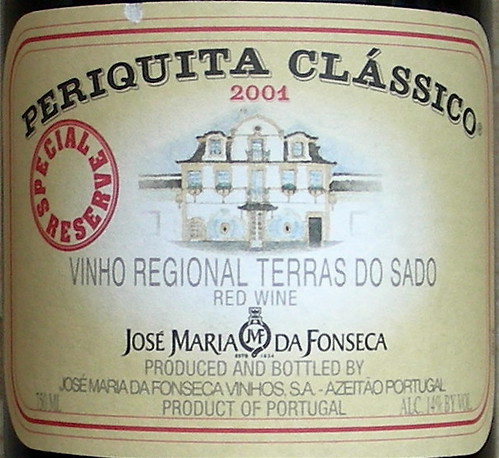 The José Maria da Fonseca estate is located not far from Lisbon on the Setúbal peninsula. It is actually the oldest producer of table wines in Portugal and has been making wines for almost 200 years. The Periquita brand was created in 1850 by José Maria da Fonseca himself. The dominant grape of the blend is Castelão, a indigenous variety planted all over southern Portugal that thrives in the sandy soils of the region.
The José Maria da Fonseca estate is located not far from Lisbon on the Setúbal peninsula. It is actually the oldest producer of table wines in Portugal and has been making wines for almost 200 years. The Periquita brand was created in 1850 by José Maria da Fonseca himself. The dominant grape of the blend is Castelão, a indigenous variety planted all over southern Portugal that thrives in the sandy soils of the region.
Periquita Classico is a Special Reserve bottling that is made only in exceptional vintages. It is 100% Castelão from a 25-acre estate vineyard in the Terras do Sado appellation, composed primarily of sand and clay-lime components . The wine has a deep garnet color. The nose is assertive, warm, and spicy. The palate is full, rich, with sweet fruit flavors. Highly Recommended, especially for the price!
Previous WBW posts:
• WBW #37: Hello Teroldego!
• WBW #34: 2002 Stella Maris Red Columbia Valley
• WBW #33: the 2004 Clot de L'Oum Compagnie des Papillons, a superb value wine from the Midi
Technorati tags:: wine food & drinkwine blogging wednesday wbw wbw38
So thanks to Ryan and Gabriella at Catavino for hosting the 38 edition of Wine Blogging Wednesday and choosing the theme of Portuguese table wines. Here I am: ready to open a bottle of 2001 José Maria da Fonseca Periquita Classico.
 The José Maria da Fonseca estate is located not far from Lisbon on the Setúbal peninsula. It is actually the oldest producer of table wines in Portugal and has been making wines for almost 200 years. The Periquita brand was created in 1850 by José Maria da Fonseca himself. The dominant grape of the blend is Castelão, a indigenous variety planted all over southern Portugal that thrives in the sandy soils of the region.
The José Maria da Fonseca estate is located not far from Lisbon on the Setúbal peninsula. It is actually the oldest producer of table wines in Portugal and has been making wines for almost 200 years. The Periquita brand was created in 1850 by José Maria da Fonseca himself. The dominant grape of the blend is Castelão, a indigenous variety planted all over southern Portugal that thrives in the sandy soils of the region.Periquita Classico is a Special Reserve bottling that is made only in exceptional vintages. It is 100% Castelão from a 25-acre estate vineyard in the Terras do Sado appellation, composed primarily of sand and clay-lime components . The wine has a deep garnet color. The nose is assertive, warm, and spicy. The palate is full, rich, with sweet fruit flavors. Highly Recommended, especially for the price!
Previous WBW posts:
• WBW #37: Hello Teroldego!
• WBW #34: 2002 Stella Maris Red Columbia Valley
• WBW #33: the 2004 Clot de L'Oum Compagnie des Papillons, a superb value wine from the Midi
Technorati tags:: wine food & drinkwine blogging wednesday wbw wbw38
Thursday, October 04, 2007
From Slovenia: the 2004 Movia Ribolla
 I wanted to try this wine because I remembered the excellent 2004 Movia Tocaj Gredic that I had last year at my Wines of Germany and Eastern Europe class.
I wanted to try this wine because I remembered the excellent 2004 Movia Tocaj Gredic that I had last year at my Wines of Germany and Eastern Europe class. The producer is the Movia Estate, one of the largest wineries in Slovenia's Brda region. The estate is made of fifteen hectares of vineyards, including seven right across the border, in Italy's Collio region (Brda is the Slovenian name for Collio and means hills). Movia has been an independent winery since 1820 and the winery owner, Ales Kristancic, was among the first winegrowers in the area to market their wines under their own brand name.
What Ales Kristancic is looking for is a complete fusion between wine, land and people. He farms his vineyard using biodynamic methods and ages his white wines in Slovenian oak casks, leaving them on the lees without stirring for more than two years. The 2004 Movia Ribolla is 100% Ribolla Gialla, one of the major indigenous white grapes from Italy's Friuli region. The name Ribolla may come from the word re-boil in Italian because the grape tends to re-ferment in spring when it gets warmer. Gialla simply means yellow. The grape is also known as Rebula on the Slovenia side.
The wine had a bright golden color. The nose was attractive with stone fruit aromas. The palate was round with some weight and subdued flavors of apple and pear. But I have to say that I was slightly disappointed by the wine. I was expecting much more acidity and fresher flavors. Maybe it was too much oak, maybe too much lees. Who knows?
Technorati tags: wine food & drink
Wednesday, September 26, 2007
My last 2007 vacation story: tasting the wines of Porquerolles Island
This will be my last vacation story but I still have to tell you about the wonderful wines that I have tasted this summer on Porquerolles Island. Porquerolles is the largest of the Iles d'Or, a group of three beautiful islands off the coast of Provence. We made several trips to the island, and of course tasted some of the local wines, as our vacation rental was conveniently located within walking distance to the ferry service.

Porquerolles Island
Although in the early twentieth century, Porquerolles had one of the largest vineyards of the region — 200 hectares of vines — most of the island is now a protected national park and only three small wineries are producing wine today, all from the Côtes de Provence appellation.
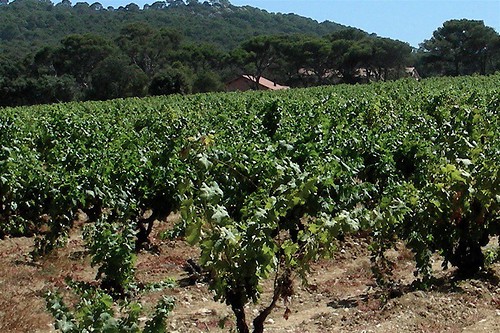 >
>
The vineyard of Domaine de l'Île
The Domaine de l'Île is the island's oldest wine estate. The owner is the grandson of François-Joseph Fournier, a wealthy Belgium engineer who bought the Porquerolles Island in 1910 after making a fortune discovering a gold and silver mine in Mexico. The vineyard is completely organic and made of Grenache and Syrah for the red wine, Grenache, Cincault, Tibouren, and Mourvèdre for the rosé, and Rolle for the white. I was able to taste the red version of the Domaine de l'Île at a local restaurant. The wine had a pleasant Côtes du Rhône character, fleshy, fruity, and peppery, although I didn't find it specially distinctive.
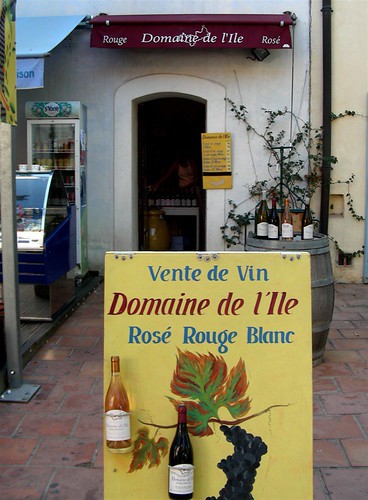
The tasting room of Domaine de l'Île
The second oldest estate is the Domaine de la Courtade. Founded in 1983, it has now 30 hectares in production. The soil is made of flaky schist which has a great capacity to store water and allows the vines to develop a deep root system. The main planted red variety is Mourvèdre which thrives here thanks to 3000 hours of sunshine a year (the highest in France) and the constant high humidity coming from the sea. Rolle, also known as Vermentino in Italy, is the main white variety. There is also an olive grove of 800 trees on the estate.
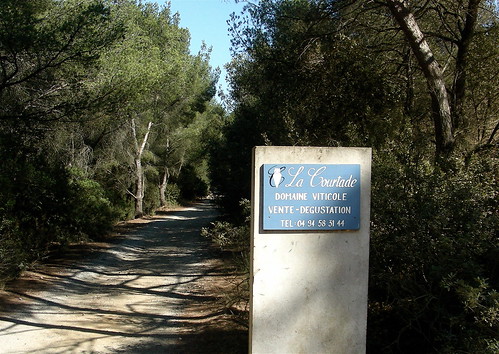
The Domaine de la Courtade
The domain uses organic practices. Yields are low, grapes are hand-picked. After fermentation, the wine is kept in casks for 9 months for the white wines, 12 to 18 months for the reds.
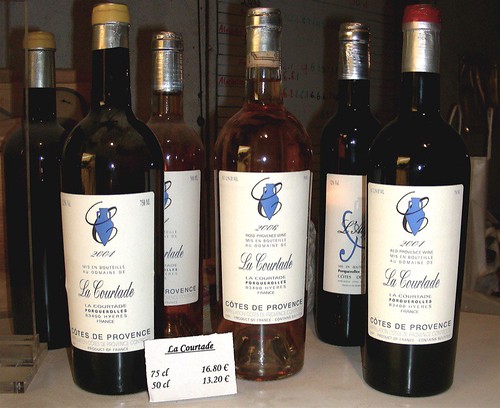
The wines at the Domaine de la Courtade
Here are the wines that we tasted at the winery:
• 2004 Côtes de Provence La Courtade Blanc: 100% Rolle. The wine can be cellared for approximately ten years. Light golden color, fragrant nose of white flower, creamy palate with a nice acidity, nutty flavors on the finish. A complex white.
• 2006 Côtes de Provence La Courtade Rosé: 70% Mourvèdre, 20% Grenache, 10% Tibouren. Pale salmon color, floral nose with citrus and berry aromas, nicely textured and refreshing palate, rather classy for a rosé.
• 2001 Côtes de Provence La Courtade Rouge: 97% Mourvèdre, 3% Syrah. The wine can be cellared for up to 15 to 20 years depending on the vintage. Deep red color, nose of red fruit, licorice and dry garrigue herbs, powerful, tannic palate, with a long finish. Really good but needs time.
Founded in the late 1980's, the Domaine Perzinsky is the youngest of the island estate. The planted varieties are Rolle and Sémillon for the white, Grenache for the rosé, and Mourvèdre and Syrah for the red. Unfortunately, I didn't have the opportunity to taste the wines of the domaine. The truth is that I spent too much time at the beach and the tasting room was closed when I arrived at the winery!
Related posts:
• 7/7/7 family reunion at the château de la Gagnotterie
• A visit at the Domaine des Huards in Cour-Cheverny
• The best table wine at less than 1 Euro
• And a Bordeaux at less than 5 Euros
Technorati tags: wine food & drink

Porquerolles Island
Although in the early twentieth century, Porquerolles had one of the largest vineyards of the region — 200 hectares of vines — most of the island is now a protected national park and only three small wineries are producing wine today, all from the Côtes de Provence appellation.
 >
>The vineyard of Domaine de l'Île
The Domaine de l'Île is the island's oldest wine estate. The owner is the grandson of François-Joseph Fournier, a wealthy Belgium engineer who bought the Porquerolles Island in 1910 after making a fortune discovering a gold and silver mine in Mexico. The vineyard is completely organic and made of Grenache and Syrah for the red wine, Grenache, Cincault, Tibouren, and Mourvèdre for the rosé, and Rolle for the white. I was able to taste the red version of the Domaine de l'Île at a local restaurant. The wine had a pleasant Côtes du Rhône character, fleshy, fruity, and peppery, although I didn't find it specially distinctive.

The tasting room of Domaine de l'Île
The second oldest estate is the Domaine de la Courtade. Founded in 1983, it has now 30 hectares in production. The soil is made of flaky schist which has a great capacity to store water and allows the vines to develop a deep root system. The main planted red variety is Mourvèdre which thrives here thanks to 3000 hours of sunshine a year (the highest in France) and the constant high humidity coming from the sea. Rolle, also known as Vermentino in Italy, is the main white variety. There is also an olive grove of 800 trees on the estate.

The Domaine de la Courtade
The domain uses organic practices. Yields are low, grapes are hand-picked. After fermentation, the wine is kept in casks for 9 months for the white wines, 12 to 18 months for the reds.

The wines at the Domaine de la Courtade
Here are the wines that we tasted at the winery:
• 2004 Côtes de Provence La Courtade Blanc: 100% Rolle. The wine can be cellared for approximately ten years. Light golden color, fragrant nose of white flower, creamy palate with a nice acidity, nutty flavors on the finish. A complex white.
• 2006 Côtes de Provence La Courtade Rosé: 70% Mourvèdre, 20% Grenache, 10% Tibouren. Pale salmon color, floral nose with citrus and berry aromas, nicely textured and refreshing palate, rather classy for a rosé.
• 2001 Côtes de Provence La Courtade Rouge: 97% Mourvèdre, 3% Syrah. The wine can be cellared for up to 15 to 20 years depending on the vintage. Deep red color, nose of red fruit, licorice and dry garrigue herbs, powerful, tannic palate, with a long finish. Really good but needs time.
Founded in the late 1980's, the Domaine Perzinsky is the youngest of the island estate. The planted varieties are Rolle and Sémillon for the white, Grenache for the rosé, and Mourvèdre and Syrah for the red. Unfortunately, I didn't have the opportunity to taste the wines of the domaine. The truth is that I spent too much time at the beach and the tasting room was closed when I arrived at the winery!
Related posts:
• 7/7/7 family reunion at the château de la Gagnotterie
• A visit at the Domaine des Huards in Cour-Cheverny
• The best table wine at less than 1 Euro
• And a Bordeaux at less than 5 Euros
Technorati tags: wine food & drink
Thursday, September 20, 2007
Beaulieu Vineyards Georges de la Tour Private Reserve Cabernet Vertical Tasting by James Strohecker
My friend James Strohecker was very lucky to attend a vertical tasting of Beaulieu Vineyards Georges de la Tour Private Reserve Cabernets. The event was organized by wine collector George Kautzman on September 6, 2007. Kindly enough, James is now sharing his tasting notes with us:
Overview
The Beaulieu Vineyards Georges De La Tour Private Reserve Cabernet tasting was a special, once-in-a-lifetime chance to sample some of the great Napa Cabernets from some great years: 1968-1976. Over the years, noted collector, George Kautzman, painstakingly acquired the Georges De La Tour Private Reserve Cabernets for the sole purpose of one day hosting vertical tastings of the wines.
The Georges De La Tour Private Reserve Cabernets were all 750 ml with generally high shoulder fills, and were pre-decanted between 5:15 p.m. and 6:15 p.m. prior to the 7:45 p.m. tasting. The wines were then blind tasted by the 11-person group, after they'd been bagged and offered to the tasters in flights of three, beginning with the youngest three wines, to the oldest three wines.
All of the Georges De La Tour Private Reserve Cabernets were purchased around the release date (generally five years after the vintage year) and original purchase price is provided as available (some bottles actually had the price tags still on them).
With regard to the (famous) 1968 vintage, the wine we tasted came from the last bottle of the second case of wine that George Kautzman had ever bought (his first case being a case of the Georges De La Tour Private Reserve Cabernet 1967 vintage). I think most of us expected this wine to knock us out of our seats and/or blow all the other vintages out of the water. The truth is, as you can read below, it didn't stand out as the highest-rated Georges De La Tour Private Reserve Cabernet of the evening.
In all, however, the majority of the wines from this era were still packed with Napa Cabernet clout; they opened up, and in some cases were remarkably edgy — but never flabby. This was simply a tremendous tasting, offered by a stellar host and collector, Mr. Kautzman.

General Notes
First flight: Great start; the 1976 vintage clearly stood out. These wines were an example of the fine Napa Cabernets that were produced by famed winemaker, Tom Selfridge.
Second flight: Only after we'd sampled the second flight, did George Kautzman read from the "White Book of California Wines", the bible on wine during that era. The 1972 Georges De La Tour Private Reserve Cabernet received a score of 11 out of 20. "The harvest was in rain and mud, with people gathering grape clusters in ankle-deep water ..." The 1972 Georges De La Tour Private Reserve Cabernet received a score of 16 out of 20.
Third flight: the best of the evening The surprise was that the 1968 Cab didn't stand out as the knock-down favorite. Feedback was varied. However, the 1969 vintage was vivid and solid; an unrecognized year with a tremendous output (from Beaulieu). Apparently, according to George Kautzman, his is not the first time that this Georges De La Tour Private Reserve Cabernet vintage has shown so well. It's been consistently great in tastings over the years.

James Strohecker

Technorati tags:: wine food & drink
Overview
The Beaulieu Vineyards Georges De La Tour Private Reserve Cabernet tasting was a special, once-in-a-lifetime chance to sample some of the great Napa Cabernets from some great years: 1968-1976. Over the years, noted collector, George Kautzman, painstakingly acquired the Georges De La Tour Private Reserve Cabernets for the sole purpose of one day hosting vertical tastings of the wines.
The Georges De La Tour Private Reserve Cabernets were all 750 ml with generally high shoulder fills, and were pre-decanted between 5:15 p.m. and 6:15 p.m. prior to the 7:45 p.m. tasting. The wines were then blind tasted by the 11-person group, after they'd been bagged and offered to the tasters in flights of three, beginning with the youngest three wines, to the oldest three wines.
All of the Georges De La Tour Private Reserve Cabernets were purchased around the release date (generally five years after the vintage year) and original purchase price is provided as available (some bottles actually had the price tags still on them).
With regard to the (famous) 1968 vintage, the wine we tasted came from the last bottle of the second case of wine that George Kautzman had ever bought (his first case being a case of the Georges De La Tour Private Reserve Cabernet 1967 vintage). I think most of us expected this wine to knock us out of our seats and/or blow all the other vintages out of the water. The truth is, as you can read below, it didn't stand out as the highest-rated Georges De La Tour Private Reserve Cabernet of the evening.
In all, however, the majority of the wines from this era were still packed with Napa Cabernet clout; they opened up, and in some cases were remarkably edgy — but never flabby. This was simply a tremendous tasting, offered by a stellar host and collector, Mr. Kautzman.

General Notes
First flight: Great start; the 1976 vintage clearly stood out. These wines were an example of the fine Napa Cabernets that were produced by famed winemaker, Tom Selfridge.
Second flight: Only after we'd sampled the second flight, did George Kautzman read from the "White Book of California Wines", the bible on wine during that era. The 1972 Georges De La Tour Private Reserve Cabernet received a score of 11 out of 20. "The harvest was in rain and mud, with people gathering grape clusters in ankle-deep water ..." The 1972 Georges De La Tour Private Reserve Cabernet received a score of 16 out of 20.
Third flight: the best of the evening The surprise was that the 1968 Cab didn't stand out as the knock-down favorite. Feedback was varied. However, the 1969 vintage was vivid and solid; an unrecognized year with a tremendous output (from Beaulieu). Apparently, according to George Kautzman, his is not the first time that this Georges De La Tour Private Reserve Cabernet vintage has shown so well. It's been consistently great in tastings over the years.

| Wine | Tasting Notes |
| Roederer Estate Sparkling Wine NV | Clean, dry, refreshing — with a perky finish on the palate. Azalea blossoms and rice nose. Opened up a bit — with more flowers and a finer finish. |
| Grgich Hills 1978 Napa Valley Chardonnay | Nice, with residual fruit and pear blossom nose. Good color, with a polished finish. |
| Kenwood 1979 Deltane Ranch Sonoma Valley Chardonnay | Very apple cider nose with a light, caramel finish. Color had changed to a cream soda look; nutty and Sauternes-like flavors on the palate. |
| Georges De La Tour Private Reserve Cabernets | (in order of flight tasting) |
| 1974 Vintage | Full nose; completed; Man, this is polished; pushing to perfection; "medicinal nose." 4 votes for best. ($16.99 original price) |
| 1975 Vintage | Latent palate finish; "edgy and unbalanced," a little barnyard with some chocolate, less finished or polished. A second (delayed) tasting of this brought this reaction from me: "A lot of character." ($12.95 original price) |
| 1976 Vintage | This really sings; younger, with more bounce; Ummmm!; nice, nice finish. "Fresh fruit, nice and balanced." ($16.99 original price) |
| 1971 Vintage | Wow, Surprising finish; "Only 1/3 the menthol as the 1973." |
| 1972 Vintage | Polished; full; driven. Berry, with a bouncy finish and a smooth nose. Some choco-berry hanging in the palate. |
| 1973 Vintage | Rich; classic; slight menthol nose. |
| 1968 Vintage | Chocolate and Napa soil; tobacco and spice. "Trunk of the car wine!" Very firm and diverse; food friendly. Leftover "muscle memory" from a great year. But it's the right time to consume this wine — it's not going to get any better. |
| 1969 Vintage | Plush. Awesome. Complete. Holding steady & expanding into berry land. Surprisingly excellent. |
| 1970 Vintage | Very, very good; this is an epitome of the Cabernet; cigar box nose; fruit intact; a lot of open-field room to move. The favorite of the tasters for the evening |
James Strohecker

Technorati tags:: wine food & drink
Wednesday, September 12, 2007
WBW #37: Hello Teroldego!
I am afraid I missed two Wine Blogging Wednesday events during the summer. Nevertheless, I am back this month for this 37th edition hosted by Tyler better known as Dr Vino. This month Tyler has asked us to say goodbye to Chardonnay and venture off the beaten path: go native!
So here we are, off the beaten path, with a bottle of Teroldigo Rotaliano. Have you ever heard of Teroldego Rotaliano? As far as I am concerned, I don't think I ever tasted such a wine before so I was quite happy to find this bottle at my local wine store last week. Teroldego is a rare Italian red variety planted almost exclusively in Northern Trentino, in a valley called Campo Rotaliano, and its sole appellation of origin is Teroldigo Rotaliano.
Campo Rotaliano has been famous for growing grapes for centuries. It is a small glacial valley around the confluence of the Adige and Noce rivers and protected by mountains on all sides. The Dolomite Mountains bring cool air into the valley in summer and protect the vineyards against the cold in winter. The soil is mostly gravel, silt, and various alluvial deposits.
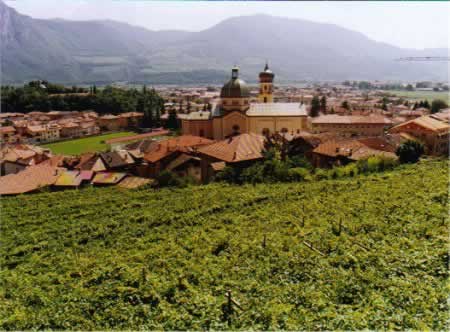
Campo Rotaliano
Teroldego is a cool-climate vine that is hardy, vigorous and potentially prolific. The fruit is not very tannic but high in color, aroma, acidity, and potential alcohol. If yield is restricted, Teroldego can produce an ageworthy wine of intense flavor. It has recently been discovered that Teroldego and the French grape variety Dureza, one of the parents of Syrah, were sibblings.
Some suggest that the name Teroldego is derived from the German term Tiroler Gold (gold of the Tirol). Most likely, Teroldego takes its name from the word tirelle, a system of wire harnesses to train the vine.
“The riches of this grape
are a tiny bit of earth
and gravel, pebbles,
and stones”
 says Elisabetta Foradori, owner of the Azienda Agricola Elisabetta Foradori and maybe Italy's finest producer of wines made from Teroldego. Her 2003 Foradori Teroldego Rotaliano has a dark red color and an assertive nose of black fruit and violet aromas and some gamey notes. On the palate, the wine is absolutely delicious, rich, complex and elegant with a lingering mineral finish, which reminds me of a softer version of a Bordeaux.
says Elisabetta Foradori, owner of the Azienda Agricola Elisabetta Foradori and maybe Italy's finest producer of wines made from Teroldego. Her 2003 Foradori Teroldego Rotaliano has a dark red color and an assertive nose of black fruit and violet aromas and some gamey notes. On the palate, the wine is absolutely delicious, rich, complex and elegant with a lingering mineral finish, which reminds me of a softer version of a Bordeaux.
What a discovery! I love being off the beaten track, thanks Tyler!
Previous WBW posts:
• WBW #34: 2002 Stella Maris Red Columbia Valley
• WBW #33: the 2004 Clot de L'Oum Compagnie des Papillons, a superb value wine from the Midi
• WBW #32: Reserve or not Reserve?
So here we are, off the beaten path, with a bottle of Teroldigo Rotaliano. Have you ever heard of Teroldego Rotaliano? As far as I am concerned, I don't think I ever tasted such a wine before so I was quite happy to find this bottle at my local wine store last week. Teroldego is a rare Italian red variety planted almost exclusively in Northern Trentino, in a valley called Campo Rotaliano, and its sole appellation of origin is Teroldigo Rotaliano.
Campo Rotaliano has been famous for growing grapes for centuries. It is a small glacial valley around the confluence of the Adige and Noce rivers and protected by mountains on all sides. The Dolomite Mountains bring cool air into the valley in summer and protect the vineyards against the cold in winter. The soil is mostly gravel, silt, and various alluvial deposits.

Campo Rotaliano
Teroldego is a cool-climate vine that is hardy, vigorous and potentially prolific. The fruit is not very tannic but high in color, aroma, acidity, and potential alcohol. If yield is restricted, Teroldego can produce an ageworthy wine of intense flavor. It has recently been discovered that Teroldego and the French grape variety Dureza, one of the parents of Syrah, were sibblings.
Some suggest that the name Teroldego is derived from the German term Tiroler Gold (gold of the Tirol). Most likely, Teroldego takes its name from the word tirelle, a system of wire harnesses to train the vine.
are a tiny bit of earth
and gravel, pebbles,
and stones”
 says Elisabetta Foradori, owner of the Azienda Agricola Elisabetta Foradori and maybe Italy's finest producer of wines made from Teroldego. Her 2003 Foradori Teroldego Rotaliano has a dark red color and an assertive nose of black fruit and violet aromas and some gamey notes. On the palate, the wine is absolutely delicious, rich, complex and elegant with a lingering mineral finish, which reminds me of a softer version of a Bordeaux.
says Elisabetta Foradori, owner of the Azienda Agricola Elisabetta Foradori and maybe Italy's finest producer of wines made from Teroldego. Her 2003 Foradori Teroldego Rotaliano has a dark red color and an assertive nose of black fruit and violet aromas and some gamey notes. On the palate, the wine is absolutely delicious, rich, complex and elegant with a lingering mineral finish, which reminds me of a softer version of a Bordeaux.What a discovery! I love being off the beaten track, thanks Tyler!
Previous WBW posts:
• WBW #34: 2002 Stella Maris Red Columbia Valley
• WBW #33: the 2004 Clot de L'Oum Compagnie des Papillons, a superb value wine from the Midi
• WBW #32: Reserve or not Reserve?
Wednesday, September 05, 2007
Guess the wines
Before Summer break, we had a special tasting event for our wine tasting club. This time, each wine had been transfered into a non related bottle to be tasted blind, and the guests were asked to identify the varietal and region of the wine. Everybody had fun, tried hard, and generally did well with several good answers. Nevertheless, our friend Jean, who was also hosting the event, was the best. He got half of the answers right and won the winning prize, a bottle of Champagne.
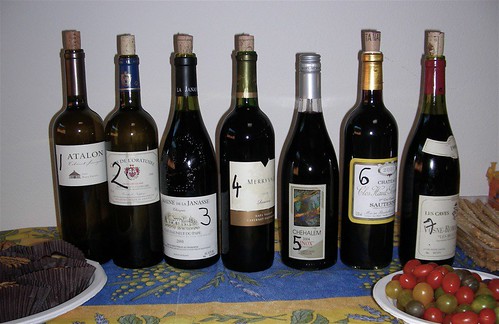
We tasted 7 different single varietal wines from different regions of the world including Australia, California, Chile, France, Italy, and Spain. Here they are:
 • 2005 Fortitude Luvisi Semillon. Fortitude is a project developed by the Etude Winery winemaking team to focus on endangered varietals such as Semillon, Valdiguie, Charbono, and Carignane. This is a 100% Semillon from 25-year old vines grown in the Luvisi family vineyard near Calistoga in Napa Valley. Showing aromas of citrus and honey, the wine was medium-bodied and refreshing, and many tasters identified it as a New World Sauvignon Blanc.
• 2005 Fortitude Luvisi Semillon. Fortitude is a project developed by the Etude Winery winemaking team to focus on endangered varietals such as Semillon, Valdiguie, Charbono, and Carignane. This is a 100% Semillon from 25-year old vines grown in the Luvisi family vineyard near Calistoga in Napa Valley. Showing aromas of citrus and honey, the wine was medium-bodied and refreshing, and many tasters identified it as a New World Sauvignon Blanc.
 • 2005 Step Road Chardonnay. The wine is produced from a high altitude vineyard in the Adelaide Hills region, in South Australia. It is a cool-climate region with high winter rainfall and cool summers, ideal for Pinot Noir, Sauvignon Blanc and Chardonnay. The wine had a golden color, tropical fruit and citrus aromas and a good depth on the palate. Many tasters rightly identified the wine as a New World Chardonnay, the most cited regions being South Africa, California, and Australia.
• 2005 Step Road Chardonnay. The wine is produced from a high altitude vineyard in the Adelaide Hills region, in South Australia. It is a cool-climate region with high winter rainfall and cool summers, ideal for Pinot Noir, Sauvignon Blanc and Chardonnay. The wine had a golden color, tropical fruit and citrus aromas and a good depth on the palate. Many tasters rightly identified the wine as a New World Chardonnay, the most cited regions being South Africa, California, and Australia.
 • 2005 Valle Isarco Sudtiroler Pinot Nero: This is a Pinot Noir from the cool Alto Adige region in northern Italy also known as Sudtirol. The region is bordered by Austria to the north and by Switzerland to the north-west. The wine had a light garnet color, a fruity nose, with a good amount of acidity and slightly tannic on the palate. This light-bodied Pinot Noir was not easy to identify and many tasters thought they had recognized a Gamay.
• 2005 Valle Isarco Sudtiroler Pinot Nero: This is a Pinot Noir from the cool Alto Adige region in northern Italy also known as Sudtirol. The region is bordered by Austria to the north and by Switzerland to the north-west. The wine had a light garnet color, a fruity nose, with a good amount of acidity and slightly tannic on the palate. This light-bodied Pinot Noir was not easy to identify and many tasters thought they had recognized a Gamay.
 • 2005 Fleurie Clos de la Roilette : the Clos de la Roilette is a nine hectare east-facing vineyard in Beaujolais' Fleurie appellation, bordering the famed Moulin-à-Vent appellation. The soil is clay and manganese, the vines are on average 25-33 years old. The wine is 100% Gamay with a deep purple color, peony and red berry aromas, a medium-bodied palate with a well-balanced acidity. This one was rightly identified as a French Gamay by many tasters.
• 2005 Fleurie Clos de la Roilette : the Clos de la Roilette is a nine hectare east-facing vineyard in Beaujolais' Fleurie appellation, bordering the famed Moulin-à-Vent appellation. The soil is clay and manganese, the vines are on average 25-33 years old. The wine is 100% Gamay with a deep purple color, peony and red berry aromas, a medium-bodied palate with a well-balanced acidity. This one was rightly identified as a French Gamay by many tasters.
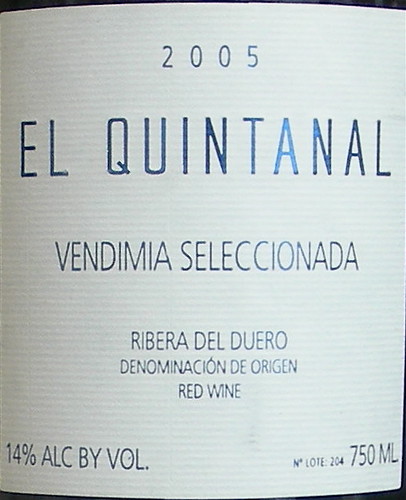 • 2005 El Quintanal Vendimia Seleccionada: the wine is a 100% Tempranillo from Spain's Ribera del Duero region. In the Ribera del Duero appellation, vineyards lie on either side of the Douro river, on a high-altitude plateau with cool nights and low rainfall, ideal growing conditions for the Spanish native grape Tempranillo. With a deep color, a black fruit nose, a ripe and spicy palate, this was tricky wine identified as a California Zinfandel by many tasters.
• 2005 El Quintanal Vendimia Seleccionada: the wine is a 100% Tempranillo from Spain's Ribera del Duero region. In the Ribera del Duero appellation, vineyards lie on either side of the Douro river, on a high-altitude plateau with cool nights and low rainfall, ideal growing conditions for the Spanish native grape Tempranillo. With a deep color, a black fruit nose, a ripe and spicy palate, this was tricky wine identified as a California Zinfandel by many tasters.
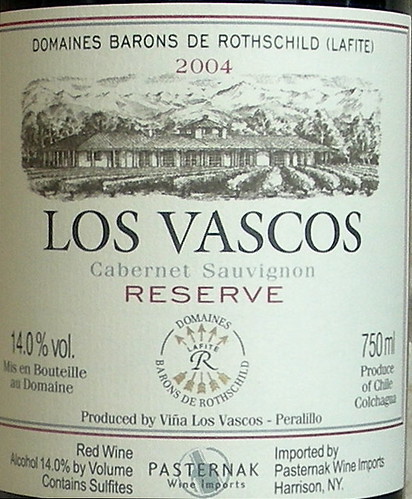 • 2004 Los Vascos Cabernet Sauvignon Reserve: Viña Los Vascos, located in Chile's Colchagua Valley, is owned by the Domaines Barons de Rothschild-Lafite. Vascos means Basques and is a reference to the estate's Basque origin. This is a Cabernet Sauvignon with a dark red/purple color, black fruit and licorice aromas and a well balanced and elegant palate. Many tasters rightly identified the wine to be a New World Cabernet Sauvignon. The most cited regions were California, Argentina, and Chile.
• 2004 Los Vascos Cabernet Sauvignon Reserve: Viña Los Vascos, located in Chile's Colchagua Valley, is owned by the Domaines Barons de Rothschild-Lafite. Vascos means Basques and is a reference to the estate's Basque origin. This is a Cabernet Sauvignon with a dark red/purple color, black fruit and licorice aromas and a well balanced and elegant palate. Many tasters rightly identified the wine to be a New World Cabernet Sauvignon. The most cited regions were California, Argentina, and Chile.
 • 2005 Ridge Zinfandel Ponzo Vineyard: Ponzo Vineyard is a cool-climate vineyard located in California's Russian River Valley. It has small amounts of Carignane and Petite Sirah interplanted with Zinfandel in the oldest blocks. The wine had a deep color, a blackberry and cherry nose, and a fleshy, spicy texture on the palate. Many guessed rightly recognized a California wine, a few identified a Zinfandel, others thought that it was a Syrah.
• 2005 Ridge Zinfandel Ponzo Vineyard: Ponzo Vineyard is a cool-climate vineyard located in California's Russian River Valley. It has small amounts of Carignane and Petite Sirah interplanted with Zinfandel in the oldest blocks. The wine had a deep color, a blackberry and cherry nose, and a fleshy, spicy texture on the palate. Many guessed rightly recognized a California wine, a few identified a Zinfandel, others thought that it was a Syrah.
Our next tasting event will feature summer wines from around the Mediterranean Sea so let's stay in touch.
Previous wine club tastings:
• Tasting the wines of Australia and New Zealand
• Tasting the wines of Piedmont
• Champagne Tasting
Technorati tags: wine food & drink

We tasted 7 different single varietal wines from different regions of the world including Australia, California, Chile, France, Italy, and Spain. Here they are:
 • 2005 Fortitude Luvisi Semillon. Fortitude is a project developed by the Etude Winery winemaking team to focus on endangered varietals such as Semillon, Valdiguie, Charbono, and Carignane. This is a 100% Semillon from 25-year old vines grown in the Luvisi family vineyard near Calistoga in Napa Valley. Showing aromas of citrus and honey, the wine was medium-bodied and refreshing, and many tasters identified it as a New World Sauvignon Blanc.
• 2005 Fortitude Luvisi Semillon. Fortitude is a project developed by the Etude Winery winemaking team to focus on endangered varietals such as Semillon, Valdiguie, Charbono, and Carignane. This is a 100% Semillon from 25-year old vines grown in the Luvisi family vineyard near Calistoga in Napa Valley. Showing aromas of citrus and honey, the wine was medium-bodied and refreshing, and many tasters identified it as a New World Sauvignon Blanc. • 2005 Step Road Chardonnay. The wine is produced from a high altitude vineyard in the Adelaide Hills region, in South Australia. It is a cool-climate region with high winter rainfall and cool summers, ideal for Pinot Noir, Sauvignon Blanc and Chardonnay. The wine had a golden color, tropical fruit and citrus aromas and a good depth on the palate. Many tasters rightly identified the wine as a New World Chardonnay, the most cited regions being South Africa, California, and Australia.
• 2005 Step Road Chardonnay. The wine is produced from a high altitude vineyard in the Adelaide Hills region, in South Australia. It is a cool-climate region with high winter rainfall and cool summers, ideal for Pinot Noir, Sauvignon Blanc and Chardonnay. The wine had a golden color, tropical fruit and citrus aromas and a good depth on the palate. Many tasters rightly identified the wine as a New World Chardonnay, the most cited regions being South Africa, California, and Australia. • 2005 Valle Isarco Sudtiroler Pinot Nero: This is a Pinot Noir from the cool Alto Adige region in northern Italy also known as Sudtirol. The region is bordered by Austria to the north and by Switzerland to the north-west. The wine had a light garnet color, a fruity nose, with a good amount of acidity and slightly tannic on the palate. This light-bodied Pinot Noir was not easy to identify and many tasters thought they had recognized a Gamay.
• 2005 Valle Isarco Sudtiroler Pinot Nero: This is a Pinot Noir from the cool Alto Adige region in northern Italy also known as Sudtirol. The region is bordered by Austria to the north and by Switzerland to the north-west. The wine had a light garnet color, a fruity nose, with a good amount of acidity and slightly tannic on the palate. This light-bodied Pinot Noir was not easy to identify and many tasters thought they had recognized a Gamay. • 2005 Fleurie Clos de la Roilette : the Clos de la Roilette is a nine hectare east-facing vineyard in Beaujolais' Fleurie appellation, bordering the famed Moulin-à-Vent appellation. The soil is clay and manganese, the vines are on average 25-33 years old. The wine is 100% Gamay with a deep purple color, peony and red berry aromas, a medium-bodied palate with a well-balanced acidity. This one was rightly identified as a French Gamay by many tasters.
• 2005 Fleurie Clos de la Roilette : the Clos de la Roilette is a nine hectare east-facing vineyard in Beaujolais' Fleurie appellation, bordering the famed Moulin-à-Vent appellation. The soil is clay and manganese, the vines are on average 25-33 years old. The wine is 100% Gamay with a deep purple color, peony and red berry aromas, a medium-bodied palate with a well-balanced acidity. This one was rightly identified as a French Gamay by many tasters. • 2005 El Quintanal Vendimia Seleccionada: the wine is a 100% Tempranillo from Spain's Ribera del Duero region. In the Ribera del Duero appellation, vineyards lie on either side of the Douro river, on a high-altitude plateau with cool nights and low rainfall, ideal growing conditions for the Spanish native grape Tempranillo. With a deep color, a black fruit nose, a ripe and spicy palate, this was tricky wine identified as a California Zinfandel by many tasters.
• 2005 El Quintanal Vendimia Seleccionada: the wine is a 100% Tempranillo from Spain's Ribera del Duero region. In the Ribera del Duero appellation, vineyards lie on either side of the Douro river, on a high-altitude plateau with cool nights and low rainfall, ideal growing conditions for the Spanish native grape Tempranillo. With a deep color, a black fruit nose, a ripe and spicy palate, this was tricky wine identified as a California Zinfandel by many tasters.  • 2004 Los Vascos Cabernet Sauvignon Reserve: Viña Los Vascos, located in Chile's Colchagua Valley, is owned by the Domaines Barons de Rothschild-Lafite. Vascos means Basques and is a reference to the estate's Basque origin. This is a Cabernet Sauvignon with a dark red/purple color, black fruit and licorice aromas and a well balanced and elegant palate. Many tasters rightly identified the wine to be a New World Cabernet Sauvignon. The most cited regions were California, Argentina, and Chile.
• 2004 Los Vascos Cabernet Sauvignon Reserve: Viña Los Vascos, located in Chile's Colchagua Valley, is owned by the Domaines Barons de Rothschild-Lafite. Vascos means Basques and is a reference to the estate's Basque origin. This is a Cabernet Sauvignon with a dark red/purple color, black fruit and licorice aromas and a well balanced and elegant palate. Many tasters rightly identified the wine to be a New World Cabernet Sauvignon. The most cited regions were California, Argentina, and Chile. • 2005 Ridge Zinfandel Ponzo Vineyard: Ponzo Vineyard is a cool-climate vineyard located in California's Russian River Valley. It has small amounts of Carignane and Petite Sirah interplanted with Zinfandel in the oldest blocks. The wine had a deep color, a blackberry and cherry nose, and a fleshy, spicy texture on the palate. Many guessed rightly recognized a California wine, a few identified a Zinfandel, others thought that it was a Syrah.
• 2005 Ridge Zinfandel Ponzo Vineyard: Ponzo Vineyard is a cool-climate vineyard located in California's Russian River Valley. It has small amounts of Carignane and Petite Sirah interplanted with Zinfandel in the oldest blocks. The wine had a deep color, a blackberry and cherry nose, and a fleshy, spicy texture on the palate. Many guessed rightly recognized a California wine, a few identified a Zinfandel, others thought that it was a Syrah. Our next tasting event will feature summer wines from around the Mediterranean Sea so let's stay in touch.
Previous wine club tastings:
• Tasting the wines of Australia and New Zealand
• Tasting the wines of Piedmont
• Champagne Tasting
Technorati tags: wine food & drink
Subscribe to:
Posts (Atom)